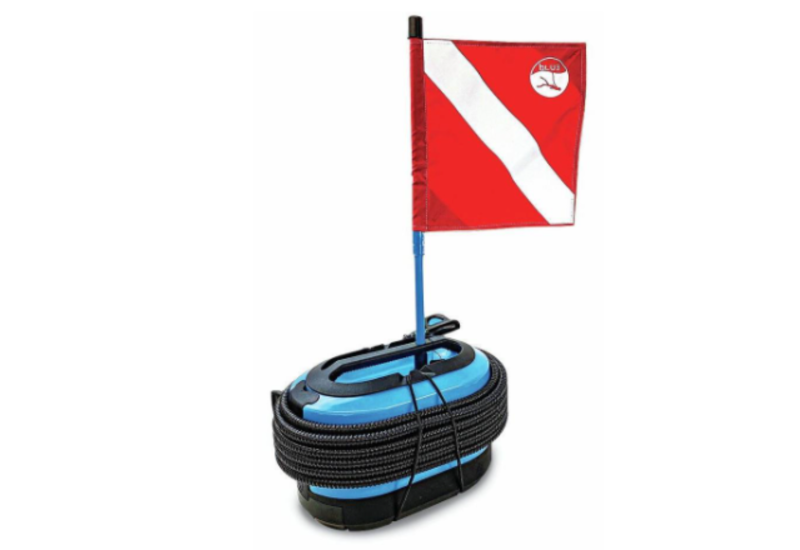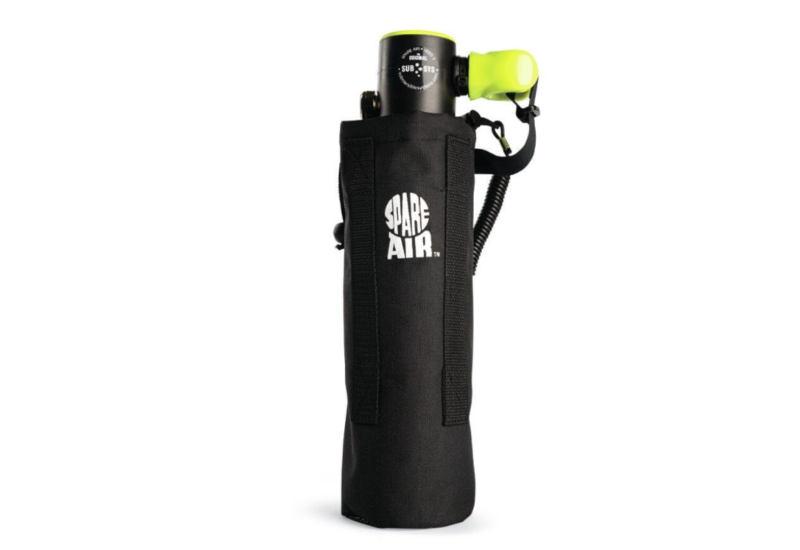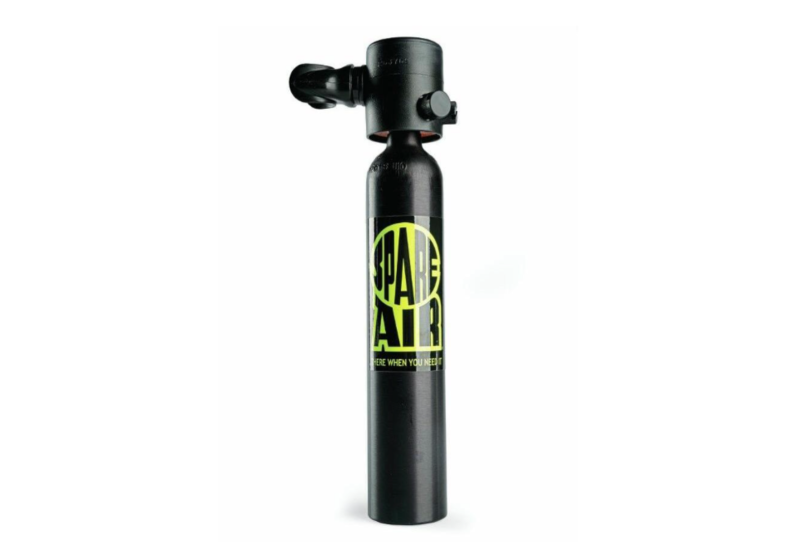2005's Best New Breathers
 |
| From the June 2005 issue of Scuba Diving magazine |
By John Brumm
Photography by Joseph Byrd
Regulators in This Article
| AERIS A1 AQUA LUNG Mistral ATOMIC Z2 ATOMIC AQUATICS T2 CRESSI-SUB Ellipse Titanium DIVE RITE RG2500 MARES Abyss 05 MARES Metal Tech LE MARES MR12 Rebel | OCEANIC Alpha 8 Sport OCEANIC Alpha 8/PX-3 OCEANIC Delta 4/FDX-10 OCEANIC GT 3/CDX-5 OCEANIC ZX TUSA RS-340 TUSA RS-460 X-Pert XS SCUBA SeaAir Tri-Metal |
You won't find a better example of the range of first-rate regulators available to recreational divers these days than this year's crop of new breathers. There are no-frills models and models loaded with innovative features. There are workhorse regs and there are racehorse regs. There are regs that cost just a couple hundred bucks, and one that costs six times as much.
But here's the best part: Our tests show all of these regs offer superior breathing performance within the bounds of recreational diving. And based on test diver feedback, this group of regs is among the most user-friendly we've ever tested.
If you're shopping for a new reg, you have 12 great choices. So what's your preference? Do you want the most advanced reg on the market, or something basic? Do you like multiple adjustments, or do you prefer to keep it simple? Is price no object or the prime consideration? Whatever priorities you may hold, there's a reg here that will fit your style while letting you breathe oh-so-easy.
Putting Them to the Test
For this review, we defined "new" regs as those released in the past year or not yet reviewed by Scuba Lab, and we invited every manufacturer we know of to send us a test model. Most companies with a qualifying product were eager to participate, though some companies didn't respond.
After reading all the manuals and making sure all the parts were assembled, we loaded the regs and our test divers onto the dive boat Island Time and headed to Catalina Island, Calif., for three days of in-water testing. On dive after dive, we put the regs through their paces. Each diver rated each reg in seven ergonomic categories, ranging from dryness and ease of breathing in a variety of swimming positions, to bubble interference and comfort. Performance was recorded using both numeric scores on a 1 to 5 scale and written comments from each test diver.
For the final phase, we traveled to Panama City Beach, Fla., where we put the regs to work on an ANSTI breathing simulator. Each reg was tested at a variety of RMVs (breathing rates) and depths. In total, we captured more than 100 pages of breathing loops--a graphic showing each reg's total inhalation and exhalation performance. This data was also translated into numeric scores on a 2 to 5 scale. The total scores from both ergo and simulator tests were then combined to reveal this year's top breathers. The following reviews are a summary of scores and test diver comments. Our complete findings are detailed in charts [see above links]. Whenever you see the words Excellent, Very Good, Good, Fair or Poor in bold in the reviews, they correspond to specific scores in the charts.
Missing in Action
All regulator manufacturers and distributors were invited to participate in this review. Some didn't have products that qualified as new. Some didn't have production models ready in time. Some companies didn't respond to our invitation. Here's a breakdown of the missing:
Apeks, Dacor, Genesis, Poseidon, Sherwood and Zeagle did not have new models that qualified for this review.
Apollo Sports, Beuchat and Scubapro all had new, redesigned or previously unreviewed regulators that did qualify, but these companies did not respond to our repeated invitations.
Over $500 Tester's Choice
There's only one regulator in this year's contest that falls in the Over $500 category, and oh what a reg it is. This powerhouse reg smashed all previous records for low work of breathing on the ANSTI simulator and for in-water performance, collecting more Excellent scores than any regulator we've tested.
||
|---|
|

|
| ATOMIC AQUATICS T2|
ATOMIC AQUATICS T2
Scuba Lab: Tester's Choice
Simulator Score: 25 out of a possible 25.
Ergo Scores: 68 out of a possible 70.
If you're a believer in the adage, "You get what you pay for," then you're going to love the T2 from Atomic Aquatics.
This sleek-looking super breather is the Ferrari of regulators, with a price to match--$1,399. But just look at what you get for your money. Both first and second stages are built with solid billet titanium components, creating a corrosion-free breathing system that weighs less than two pounds. The first stage has a low-pressure port turret for easy hose routing. The second stage features an all-titanium version of Atomic's Comfort Swivel, which we consider the ultimate in second-stage swivel designs. The reg also uses Atomic's patented Automatic Flow Control, a depth-activated venturi control that automatically balances breathing performance and stability as depths increase.
In breathing simulator tests, the T2 smoked every RMV/depth category, delivering a perfect score without breaking a sweat. So we turned up the heat. But when we punched in extremely stressful breathing rates and excessive depths, the reg smoked those too. It didn't seem to matter what RMV or depth we threw at it, the T2 continued to breathe like a dream. (Editor's Note: Look for a full review of high-performance regs in the November 2005 issue of Scuba Diving.)
When we took the T2 into the ocean it repeated this superhero performance, scoring Excellent for ease of breathing regardless of position. In fact, the reg earned Excellent scores in all ergo categories except bubble interference, where it earned a Very Good. This represents the highest total ergo score of any regulator tested in the past four years.
The T2 comes with a factory-sealed first stage for cold-water performance, and a dual silicone mouthpiece with firm bite-down lugs to prevent over-clenching. It also includes a padded regulator bag with zippered pouches and a shoulder strap, plus a limited lifetime warranty that's not contingent on annual service--not to mention the prestige of owning an elite piece of gear. Under $500 Tester's Choice
The top performers in this price category all delivered Very Good to Excellent performance on the breathing simulator. In ergo tests, the SeaAir Tri-Metal and RS-460 X-Pert earned across-the-board Very Good scores in the most important categories (ease of breathing in the swimming position, ease of breathing in different positions and dryness), but the Delta 4 and Abyss 05 edged ahead in total points, including Excellent scores for ease of breathing in the swimming position.
||
|---|
|

|
| OCEANIC Delta 4/FDX-10|
OCEANIC Delta 4/FDX-10
Scuba Lab: Tester's Choice
Simulator score: 23 out of a possible 25.
Ergo score: 58 out of a possible 70.
Oceanic's new Delta 4/FDX-10 is loaded with goodies. The FDX-10 balanced diaphragm first stage offers an Oceanic exclusive--Dry Reg Technology (DRT). When not attached to a tank, this new high-pressure inlet is blocked by a spring-loaded seal that keeps moisture and contaminants from sneaking into the first stage, even if the dust cap is left off. When you turn the tank on, air pressure opens the seal, and according to Oceanic the design doesn't affect breathing performance. The Delta 4 is the first Oceanic reg to feature DRT, but you can expect to see the feature on the company's entire line before long.
The Delta 4 second stage is fitted with Oceanic's patented Dynamic Adjustment. According to Oceanic, this is a mechanical balancing system that maintains a consistent opening effort throughout the dive. Simply find the sweet spot in your inhalation effort by dialing the adjustment knob in or out, then leave it alone; from then on, the reg will automatically adjust itself to any changes in depth. The Delta 4 also comes with a swivel between the low-pressure hose and the second-stage housing and an orthodontic mouthpiece that allows for the natural overbite of the human jaw.
Hooked up to the breathing simulator, the Delta 4 delivered Very Good to Excellent performance in all the RMV/depth categories, earning the highest simulator scores of all the regs in this price group. In ocean tests, the reg was also a champion, collecting the highest total ergo score in its price group. It drew favorable comments from test divers for easy breathing, easy purging and for comfort. In particular, divers liked the swivel and the mouthpiece, and felt both the adjustment knob and dive/pre-dive switch were easy to use, even when wearing gloves. However, the dive/pre-dive switch markings are minuscule and can be difficult to see when wearing a mask. We reported this to Oceanic, who promised they would look into it.
||
|---|
|

|
| MARES Abyss 05|
MARES Abyss 05
Scuba Lab: Tester's Choice
Simulator score: 22 out of a possible 25.
Ergo Score: 57 out of a possible 70.
With an all-metal, non-adjustable second stage and a beefy, balanced diaphragm first stage, the Abyss 05 is simple to use and virtually bulletproof. The second stage is made of nickel and chrome-plated brass and incorporates Mares' Vortex Assisted Design (VAD) to improve breathing at all depths. The air coming through the low-pressure hose is directed to the mouthpiece through a bypass tube, creating a vortex that, according to Mares, increases breathing sensitivity. The MR22 first stage uses Mares' Dynamic Flow Control (DFC), a system that minimizes intermediate pressure drop during inhalation. With less inhalation resistance, breathing is easier.
So easy, in fact, that the Abyss tied for the second-highest breathing simulator performance in its price range. In ocean tests, it earned an Excellent for ease of breathing in the swimming position and Very Good for breathing in different positions. According to test divers, the reg breathes effortlessly, is quiet and stays dry regardless of what position you're in. The purge button is responsive, too. Made of metal, the second stage is a bit heavier than some other regs, but it's still comfortable. Test divers also liked the look of the second stage.
||
|---|
|

|
| XS Scuba SeaAir Tri-Metal|
XS Scuba SeaAir Tri-Metal
Scuba Lab: Tester's Choice, Best Buy
Simulator score: 22 out of a possible 25.
Ergo score: 56 out of a possible 70.
According to XS Scuba, the SeaAir Tri-Metal (so named because of its stainless-steel, titanium and brass components) delivers the performance of today's most expensive regs, yet is moderately priced. Based on our test results, this claim is grounded firmly in fact. Within the parameters of our standard breathing simulator tests, the Tri-Metal demonstrated Very Good to Excellent performance. Then it kept going. As RMVs and test depths increased, this reg continued to deliver air at a surprisingly low work of breathing. In short, the SeaAir Tri-Metal proved to be a real powerhouse when pushed to extremes.
The reg also proved more than able in actual ocean conditions, racking up Very Good scores in almost all ergo categories. Test divers found the reg to be a sweet breather in all positions and dry as a bone. The purge cover on the balanced second stage is a bit stiff, but unleashes a forceful rush of air for easy clearing. Although somewhat sticky, the breathing resistance knob gives you a full range of adjustment in only a couple of turns. The Tri-Metal's balanced piston first stage features a low-pressure port turret for easy hose routing and is the only reg in this group to come with a yoke rated for 4,000-psi cylinders. It carries a limited lifetime warranty. Based on its chart-topping performance and a reasonable price of $375, it's a Best Buy.
||
|---|
|

|
| TUSA RS-460 X-Pert|
TUSA RS-460 X-Pert
Scuba Lab: Tester's Choice
Simulator Score: 22 out of a possible 25.
Ergo score: 54 out of a possible 70.
Tusa's new RS-460 is a simple and efficient breather, combining a compact, balanced diaphragm first stage with a lightweight second stage. This reg tied for the second-highest breathing simulator performance in its price group and brought home Very Good scores in virtually every ergo category. According to test divers, this is a very easy breather in all positions. The reg purges effortlessly using the blowing method; the purge cover is stiff but efficient. The dive/pre-dive switch is clearly marked and easy to use, although it can be a bit hard to grasp when wearing gloves. Test divers found the reg to be dry in all positions, with a comfortable mouthpiece.
The RS-460 has two high-flow low-pressure ports on its first stage to maximize air delivery to the second stage, regardless of tank pressure. The first stage also comes with a special coating on the main spring to ensure that the regulator performs just as well in cold water. It's available with either a yoke or 300 bar DIN connection and comes with a lifetime warranty (including free parts replacement) if you purchase it from an authorized Tusa dealer and have it serviced once a year.
Under $500 Very Good Performers
While they didn't collect enough points to land in the Testers' Choice category, these regs still offer above-average breathing performance. All regs earned Good to Very Good scores in the most important ergo categories, too, with the Alpha 8 Sport leading the pack with an Excellent score for dryness.
||
|---|
|

|
| OCEANIC Alpha 8 Sport|
OCEANIC Alpha 8 Sport
Scuba Lab: Best Buy
Simulator Score: 17 out of a possible 25.
Ergo score: 57 out of a possible 70.
Oceanic's new Alpha 8 second stage replaces the popular Alpha 7. Hooked to Oceanic's new SP-5 piston first stage, which is smaller and lighter than its predecessor (the SP-4), this combo offers divers a great entry-level reg.
The Alpha 8 Sport generated Very Good simulator scores in the breathing rate/depth category most closely representing typical recreational diving, and in the water it performed with panache. Test divers found it to be "very simple and lightweight" and "a nice basic reg." The Alpha 8 Sport, which has no user adjustments, was rated above average for ease of breathing in all positions (divers noted hardly any change in breathing, even when upside down) and for its purging efficiency (the flexible purge cover was very easy to use). Finally, the Alpha 8 Sport was the only reg in its price class to earn an Excellent score for dryness in all positions. Great performance for just $224.95--it's a Best Buy.
||
|---|
|

|
| TUSA RS-340|
TUSA RS-340
Simulator Score: 17 out of a possible 25.
Ergo score: 56 out of a possible 70.
On the simulator, the RS-340 earned Good to Very Good scores for breathing performance, but it was in real-world diving conditions where the reg really strutted its stuff. Test divers rated it Very Good, both for ease of breathing in all positions and for dryness, and noted the reg generated less bubble interference than most. The purge system was also rated high for its efficiency, using either the blowing method or the easy-to-use purge button.
Test divers were drawn to Tusa's new ortho-designed mouthpiece. They also liked the second-stage swivel (located between the low-pressure hose and housing) that improved positioning and helped minimize jaw fatigue. And even those test divers who were not fans of second-stage adjustments liked the reg's clearly marked 10-position positive-click breathing resistance knob. The RS-340 comes with a lifetime warranty, including free parts, if you purchase it from an authorized Tusa dealer and have it serviced annually.
CRESSI-SUB Ellipse Titanium
||
|---|
|

|
| CRESSI-SUB Ellipse Titanium|
Simulator Score: 19 out of a possible 25.Ergo score: 54 out of a possible 70.
Divers who prefer a simple, lightweight second stage will like the Ellipse Titanium. According to Cressi-sub, the elliptical shape of the second stage allows them to use a larger diaphragm, which lowers breathing effort. Coupled to a compact first stage, the reg delivered Good to Very Good performance on the breathing simulator. In the water, it proved to be a solid breather, earning Very Good scores for ease of breathing in all positions. The reg also stayed dry at depth, and purged well using both blowing and button methods--although the purge cover is a bit stiff.
Test divers found the dive/pre-dive switch to be clearly marked and easy to use. However, they said the switch didn't do much to rein in free-flows. They also noted that our test reg delivered air with a noticeable plastic "new reg" taste to it. When we reported this to Cressi-sub, they said it tends to disappear after just a few dives (sure enough, it did). The Ellipse Titanium comes with a limited lifetime warranty, and is available in a cold-water version, the Ellipse Alaska.
||
|---|
|

|
| OCEANIC GT 3/CDX-5|
OCEANIC GT 3/CDX-5
Simulator Score: 17 out of a possible 25.
Ergo score: 54 out of a possible 70.
Like Oceanic's Delta 4, the new GT 3 hits the scene equipped with Dynamic Adjustment, a second-stage balancing system that maintains consistent opening effort throughout the dive. Simply find your desired inhalation effort by dialing the adjustment knob in or out. Then leave it alone; the reg will automatically adjust itself to any changes in depth. The GT 3 doesn't come with a dive/pre-dive switch. According to Oceanic, the redesigned casing eliminates the need for this additional adjustment.
The CDX-5 first stage is a balanced diaphragm design that's equipped with an environmental kit for cold-water diving. Teamed up with the GT 3, this reg combo delivered Very Good performance on the breathing simulator in the RMV/depth category representing recreational diving. It then went on to earn Good marks at higher breathing rates and greater depths. In the water, the GT 3 proved to be a comfortable reg with its ortho-designed mouthpiece. Test divers rated it Very Good for ease of breathing in all positions, and found it to be a dry reg in all situations.
||
|---|
|

|
| AERIS A1|
AERIS A1
Simulator Score: 17 out of a possible 25.
Ergo score: 54 out of a possible 70.
Comments from divers reaching the surface after test-diving the Aeris A1 included "Surprisingly easy breather," "Great reg," and simply, "How much? I'll take it!"
The reg is designed with simplicity in mind. The second stage, made of a lightweight ABS/polycarbonate composite, has no user adjustments, and the compact first stage is an unbalanced piston design. The reg easily delivered Very Good breathing simulator performance in the RMV/depth category representing typical recreational diving--the category it was designed for. It also earned Good simulator scores in tests using the more extreme depths and breathing rates. According to Aeris, the sweet breathing characteristics of this reg are due to a unique second-stage deflector vane and housing design that produce smooth venturi-assisted inhalation.
Ergo tests bear this out. Test divers rated the A1 Very Good for ease of breathing in all positions and for dryness. The reg's purge system also scored points for efficiency. An orthodontically designed mouthpiece contributed to the reg's Very Good score for comfort. {mospagebreak} Under $500 Very Good Performers - continued
||
|---|
|

|
| DIVE RITE RG2500|
DIVE RITE RG2500
Simulator Score: 18 out of a possible 25.
Ergo Scores: 53 out of a possible 70.
Dive Rite's new RG2500 is the only reg in this go-round that comes standard with a DIN valve (a yoke-style adapter, pictured, is available). The no-nonsense first stage offers a rotating low-pressure port turret to simplify hose routing. The balanced second stage features a breathing resistance knob with a wide range of adjustment.
On the simulator, the RG2500 earned Very Good to Excellent scores in the first three breathing machine tests. During ocean tests, the reg earned Very Good marks from test divers for ease of breathing in the swimming position and for dryness. It also had less bubble interference than most regs. Divers liked the flexible purge cover, but felt the markings on the dive/pre-dive switch were hard to see. In response to these comments, Dive Rite reminded us that the lever is designed to point up the hose when the reg is in dive mode. This provides a tactile indicator useful in low-visibility situations. The RG2500 comes with a limited lifetime warranty and two-year service program. It's also available in a cold-water version, the RG2500 Ice.
||
|---|
|

|
| MARES MR12 Rebel|
MARES MR12 Rebel
Simulator Score: 22 out of a possible 25.
Ergo score: 48 out of a possible 70.
Simplicity is the key for Mares' new Rebel, which is both lightweight and free of user-adjustments. The reg also uses a mesh grid second-stage faceplate designed to minimize free-flows when swimming into strong currents. Like the Abyss 05, the Rebel also incorporates Mares' Vortex Assisted Design, or VAD, a system designed to improve breathing at all depths. The tried-and-true MR12 first stage uses Dynamic Flow Control, a priority low-pressure port for the primary second stage.
The Rebel tied for second-highest performance on the breathing simulator in the Under $500 price group. It earned an Excellent score in the RMV/depth category most closely representing recreational diving and Very Good scores in all other categories.
In the water, test divers scored the reg as a Good breather both in the swimming position and in alternate positions, and found it to be a very dry breather in all positions. Among its highlights: a purge button that is easy to find and that works efficiently. The Rebel's mouthpiece is comfortable too.
Back to the Future: AQUA LUNG Mistral
||
|---|
|

|
| AQUA LUNG Mistral|
Divers nostalgic for the Sea Hunt era will get a kick out of the new Mistral double-hose reg from Aqua Lung. This version is true to the original 1950s design--the first and second stages are joined at the tank and corrugated hoses deliver air to the diver's mouth and then direct exhaust behind the diver's head. But Aqua Lung also uses modern components, like a Titan first stage and an environmentally sealed second stage. The Mistral can be used with nitrox mixes up to 40 percent and is available in both yoke and DIN versions.
This is still a double-hose reg, however, and subject to the laws of physics. When you're vertical in the water the Mistral breathes just as easy as a single-hose reg (the equivalent of a Very Good score according to our breathing machine tests). And it breathes extremely easy when you're looking up or swimming on your back. But when you go facedown, as in a head-first descent or in the standard swimming position, inhalation effort increases markedly.
For divers used to breathing off a single-hose reg this will take some getting used to, as will the old-school steps for purging the reg and buddy breathing. But if you want to explore the "good old days of gorilla diving," it's just part of the fun. Price: $900. For more information, visit www.aqualung.com.
Fashionably Late
||
|---|
|

|
| MARES Metal Tech LE|
These regulators weren't in production when we began our tests, but are expected out this year.
MARES Metal Tech LE > Part of Mares' new Limited Edition Metal line of dive gear, the Metal Tech LE first stage is 60 percent lighter than any reg made by Mares and features Dynamic Flow Control on all low-pressure ports. Only 2,000 of the regs were produced, and buyers can have their name engraved on the outer ring of the second-stage cover. Price: $699. The reg can be purchased with other Limited Edition gear--the Morphos Metal Tech LE buoyancy compensator and the Quattro Excel Metal LE fins.
ATOMIC Z2 > The second generation of Atomic's budget regulator, the Z2 promises to deliver the same breathing performance as its T2, B2 and M1 cousins. According to Atomic, it features a pneumatically balanced second stage, Atomic's Automatic Flow Control, a titanium seat-saving orifice, a rapid adjustment knob and a new second-stage casing. Price: $399.
||
|---|
|

|
| OCEANIC ZX|
OCEANIC ZX > The ZX is a super-compact, pneumatically balanced second stage that attaches to Oceanic's slick new FDX-10 first stage with Dry Reg Technology (DRT). The smallest and lightest second stage in Oceanic's line, the ZX uses the same 30-degree inline swivel as the Delta 4 and the same rubberized adjustment knob. Price: $599.
Oceanic Alpha 8/PX-3 > This is the same second stage used on the Alpha 8 Sport, mated to a balanced piston PX-3 first stage. New for this year, the PX-3 now comes with a fifth low-pressure port to increase hose placement options. Price: $299.95.
2004 Testers' Choices
Still looking for the perfect reg? Here are last year's top performers and their test scores. They're still in distribution, and definitely worth a look.
Under $500
Aqua Lung Calypso
Simulator Score: 19 out of a possible 20.
Ergo Score: 53 out of a possible 70. An updated version of an old favorite, the Calypso is a dry, easy breather that offers a lot reg for not a lot of money.
Price: $269.
Mares MR12/Axis Pro
Simulator Score: 19 out of a possible 20.
Ergo Score: 50 out of a possible 70. A balanced diaphragm first stage hooked to a simple adjustment-free second stage. A great breather in the normal swimming position.
Price: $249.
Mares R2/Axis Pro
Simulator Score: 18 out of a possible 20.
Ergo Score: 50 out of a possible 70. Easy on the wallet, but packed with performance. This unbalanced piston first stage earned positive comments from test divers for its ease of breathing.
Price: $209.
Over $500
Scubapro MK25/X650
Simulator Score: 20 out of a possible 20.
Ergo Score: 57 out of a possible 70. Earned a perfect simulator score and the highest total score for ergonomic performance of any reg we tested in 2004.
Price: $602.
Zeagle Flathead VI/ZX
Simulator Score: 20 out of a possible 20.
Ergo Score: 55 out of a possible 70. Zeagle's flagship reg aced our simulator tests. In the water, test divers rated it Very Good for ease of breathing in all positions.
Price: $598.
Regulator Features to Consider
Piston or diaphragm first stage. > To admit air from the tank into the regulator, first stages use a piston sliding in a smooth cylinder or a diaphragm (like a loose drumhead) that flexes. Each has advantages and disadvantages, but both can offer excellent breathing performance.
> Balanced or unbalanced first stage. Balancing is an attempt to keep air delivery stable when tank pressures are low or demand on the regulator is high. However, many unbalanced first stages offer breathing performance very similar to balanced ones.
> Number of ports. More ports means better hose routing options.
> Balanced or unbalanced second stages. Balanced second stages can make the airflow more consistent, but most modern unbalanced second stages do just as well in the ergo and simulator tests.
> Dive/Pre-dive switch. A second-stage adjustment useful to prevent free-flows on the surface. > Breathing resistance knob. Designed to be used under water, they can be used to tune out positive pressure breathing and free-flows caused by current.
> Nitrox capability. In this test, all the regs come factory-ready for oxygen-enriched breathing gases.
> Environmental sealing. Environmentally sealed first stages keep water out of the workings to prevent icing in cold (below 50 degrees) or contamination in dirty water.
> Warranty: Range from two-year limited to limited lifetime; some manufacturers offer upgraded warranties as an option.
How (And Why) We Test Regulators
Scuba Lab is the only consumer products testing organization that works for the sole benefit of recreational divers. The goal of our exclusive Scuba Lab reviews (found only in Scuba Diving magazine and archived on www.scubadiving.com) is to help divers be informed consumers of dive gear.
To fulfill this mission when testing regulators, we use an industry-standard ANSTI wet breathing machine, which is capable of measuring minute differences in the inhalation and exhalation resistance at a variety of depths and breathing rates. Following internationally accepted test standards, a regulator's work of breathing (WOB) is measured in joules per liter (j/l) for each complete inhale/exhale cycle, during which the highest inhalation or exhalation pressure experienced by the "diver" should never exceed 25 millibars or a total WOB of 3 j/l.
If a reg exceeds either parameter, it "fails" our test, but that doesn't mean that it stops delivering air--only that the breathing resistance at some point in the cycle is higher than what is common for most modern regulators. All simulator tests are performed at a supply pressure of 725-760 psi. If a regulator can perform well at this low supply pressure, it will perform as well or better at higher supply pressures.
|| |---|
|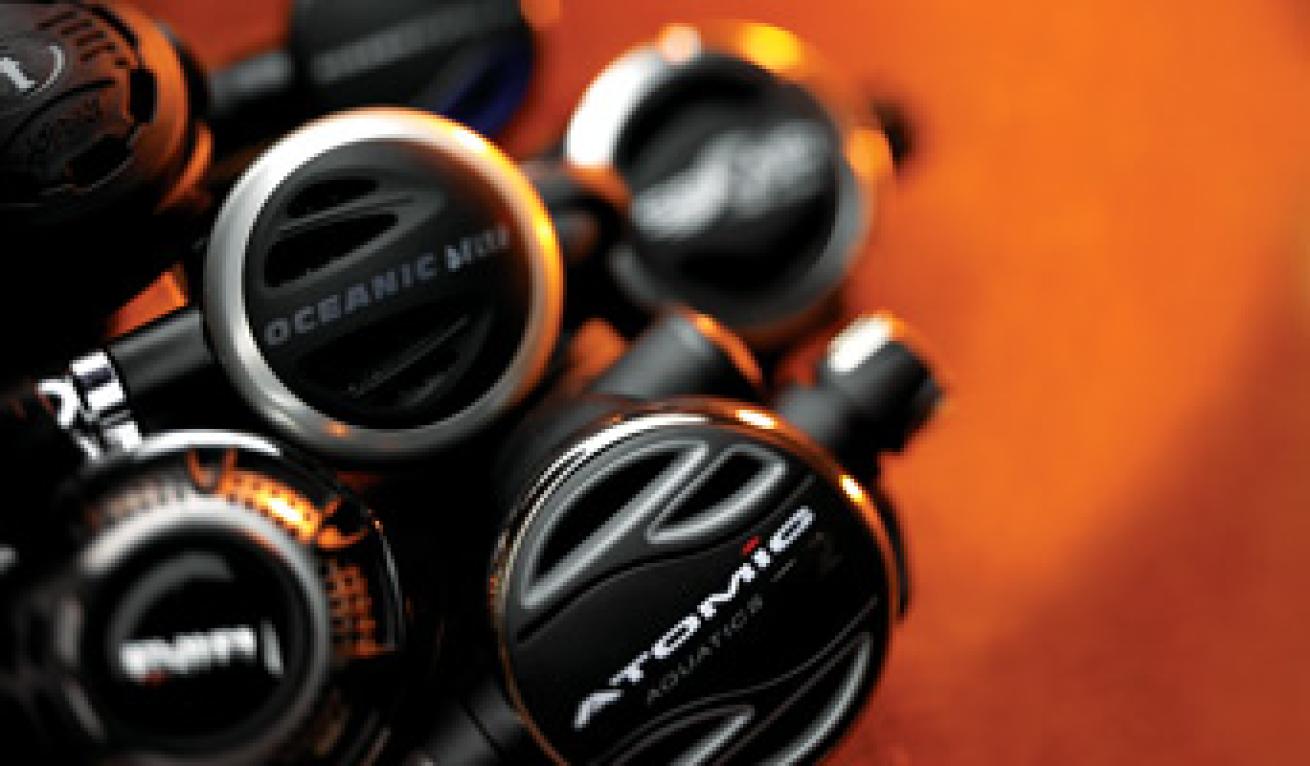
| | From the June 2005 issue of Scuba Diving magazine|
By John Brumm
Photography by Joseph Byrd
Regulators in This Article
||| |---|---|
| AERIS A1 AQUA LUNG Mistral ATOMIC Z2 ATOMIC AQUATICS T2 CRESSI-SUB Ellipse Titanium DIVE RITE RG2500 MARES Abyss 05 MARES Metal Tech LE MARES MR12 Rebel | OCEANIC Alpha 8 Sport OCEANIC Alpha 8/PX-3 OCEANIC Delta 4/FDX-10 OCEANIC GT 3/CDX-5 OCEANIC ZX TUSA RS-340 TUSA RS-460 X-Pert XS SCUBA SeaAir Tri-Metal |You won't find a better example of the range of first-rate regulators available to recreational divers these days than this year's crop of new breathers. There are no-frills models and models loaded with innovative features. There are workhorse regs and there are racehorse regs. There are regs that cost just a couple hundred bucks, and one that costs six times as much.
But here's the best part: Our tests show all of these regs offer superior breathing performance within the bounds of recreational diving. And based on test diver feedback, this group of regs is among the most user-friendly we've ever tested.
If you're shopping for a new reg, you have 12 great choices. So what's your preference? Do you want the most advanced reg on the market, or something basic? Do you like multiple adjustments, or do you prefer to keep it simple? Is price no object or the prime consideration? Whatever priorities you may hold, there's a reg here that will fit your style while letting you breathe oh-so-easy.
Putting Them to the Test
For this review, we defined "new" regs as those released in the past year or not yet reviewed by Scuba Lab, and we invited every manufacturer we know of to send us a test model. Most companies with a qualifying product were eager to participate, though some companies didn't respond.
After reading all the manuals and making sure all the parts were assembled, we loaded the regs and our test divers onto the dive boat Island Time and headed to Catalina Island, Calif., for three days of in-water testing. On dive after dive, we put the regs through their paces. Each diver rated each reg in seven ergonomic categories, ranging from dryness and ease of breathing in a variety of swimming positions, to bubble interference and comfort. Performance was recorded using both numeric scores on a 1 to 5 scale and written comments from each test diver.
For the final phase, we traveled to Panama City Beach, Fla., where we put the regs to work on an ANSTI breathing simulator. Each reg was tested at a variety of RMVs (breathing rates) and depths. In total, we captured more than 100 pages of breathing loops--a graphic showing each reg's total inhalation and exhalation performance. This data was also translated into numeric scores on a 2 to 5 scale. The total scores from both ergo and simulator tests were then combined to reveal this year's top breathers. The following reviews are a summary of scores and test diver comments. Our complete findings are detailed in charts [see above links]. Whenever you see the words Excellent, Very Good, Good, Fair or Poor in bold in the reviews, they correspond to specific scores in the charts.
Missing in Action
All regulator manufacturers and distributors were invited to participate in this review. Some didn't have products that qualified as new. Some didn't have production models ready in time. Some companies didn't respond to our invitation. Here's a breakdown of the missing:
Apeks, Dacor, Genesis, Poseidon, Sherwood and Zeagle did not have new models that qualified for this review.
Apollo Sports, Beuchat and Scubapro all had new, redesigned or previously unreviewed regulators that did qualify, but these companies did not respond to our repeated invitations.
Over $500 Tester's Choice
There's only one regulator in this year's contest that falls in the Over $500 category, and oh what a reg it is. This powerhouse reg smashed all previous records for low work of breathing on the ANSTI simulator and for in-water performance, collecting more Excellent scores than any regulator we've tested.
|| |---|
|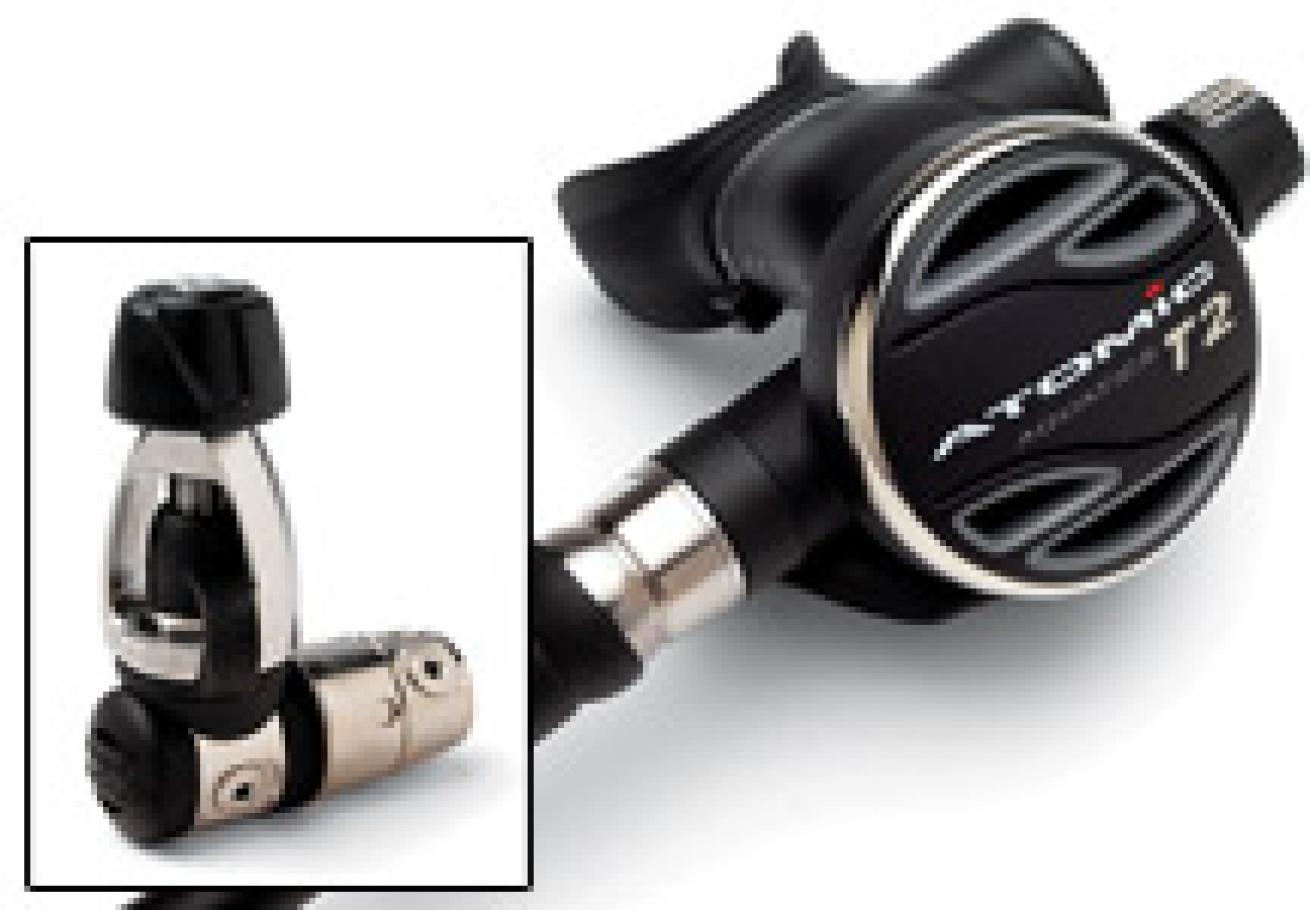
| | ATOMIC AQUATICS T2|
Scuba Lab: Tester's Choice
Simulator Score: 25 out of a possible 25.
Ergo Scores: 68 out of a possible 70.
If you're a believer in the adage, "You get what you pay for," then you're going to love the T2 from Atomic Aquatics.
This sleek-looking super breather is the Ferrari of regulators, with a price to match--$1,399. But just look at what you get for your money. Both first and second stages are built with solid billet titanium components, creating a corrosion-free breathing system that weighs less than two pounds. The first stage has a low-pressure port turret for easy hose routing. The second stage features an all-titanium version of Atomic's Comfort Swivel, which we consider the ultimate in second-stage swivel designs. The reg also uses Atomic's patented Automatic Flow Control, a depth-activated venturi control that automatically balances breathing performance and stability as depths increase.
In breathing simulator tests, the T2 smoked every RMV/depth category, delivering a perfect score without breaking a sweat. So we turned up the heat. But when we punched in extremely stressful breathing rates and excessive depths, the reg smoked those too. It didn't seem to matter what RMV or depth we threw at it, the T2 continued to breathe like a dream. (Editor's Note: Look for a full review of high-performance regs in the November 2005 issue of Scuba Diving.)
When we took the T2 into the ocean it repeated this superhero performance, scoring Excellent for ease of breathing regardless of position. In fact, the reg earned Excellent scores in all ergo categories except bubble interference, where it earned a Very Good. This represents the highest total ergo score of any regulator tested in the past four years.
The T2 comes with a factory-sealed first stage for cold-water performance, and a dual silicone mouthpiece with firm bite-down lugs to prevent over-clenching. It also includes a padded regulator bag with zippered pouches and a shoulder strap, plus a limited lifetime warranty that's not contingent on annual service--not to mention the prestige of owning an elite piece of gear. Under $500 Tester's Choice
The top performers in this price category all delivered Very Good to Excellent performance on the breathing simulator. In ergo tests, the SeaAir Tri-Metal and RS-460 X-Pert earned across-the-board Very Good scores in the most important categories (ease of breathing in the swimming position, ease of breathing in different positions and dryness), but the Delta 4 and Abyss 05 edged ahead in total points, including Excellent scores for ease of breathing in the swimming position.
|| |---|
|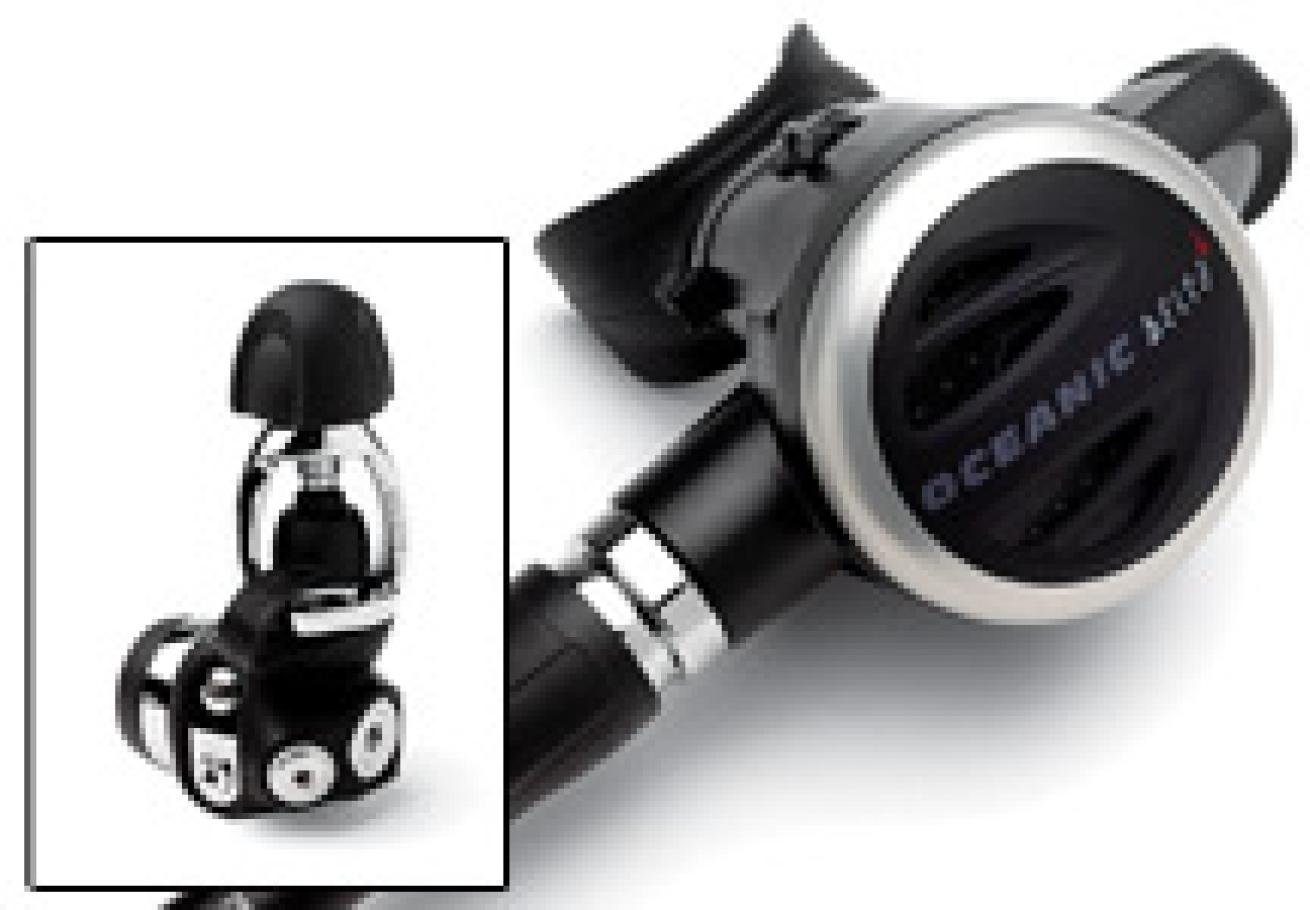
| | OCEANIC Delta 4/FDX-10|
Scuba Lab: Tester's Choice
Simulator score: 23 out of a possible 25.
Ergo score: 58 out of a possible 70.
Oceanic's new Delta 4/FDX-10 is loaded with goodies. The FDX-10 balanced diaphragm first stage offers an Oceanic exclusive--Dry Reg Technology (DRT). When not attached to a tank, this new high-pressure inlet is blocked by a spring-loaded seal that keeps moisture and contaminants from sneaking into the first stage, even if the dust cap is left off. When you turn the tank on, air pressure opens the seal, and according to Oceanic the design doesn't affect breathing performance. The Delta 4 is the first Oceanic reg to feature DRT, but you can expect to see the feature on the company's entire line before long.
The Delta 4 second stage is fitted with Oceanic's patented Dynamic Adjustment. According to Oceanic, this is a mechanical balancing system that maintains a consistent opening effort throughout the dive. Simply find the sweet spot in your inhalation effort by dialing the adjustment knob in or out, then leave it alone; from then on, the reg will automatically adjust itself to any changes in depth. The Delta 4 also comes with a swivel between the low-pressure hose and the second-stage housing and an orthodontic mouthpiece that allows for the natural overbite of the human jaw.
Hooked up to the breathing simulator, the Delta 4 delivered Very Good to Excellent performance in all the RMV/depth categories, earning the highest simulator scores of all the regs in this price group. In ocean tests, the reg was also a champion, collecting the highest total ergo score in its price group. It drew favorable comments from test divers for easy breathing, easy purging and for comfort. In particular, divers liked the swivel and the mouthpiece, and felt both the adjustment knob and dive/pre-dive switch were easy to use, even when wearing gloves. However, the dive/pre-dive switch markings are minuscule and can be difficult to see when wearing a mask. We reported this to Oceanic, who promised they would look into it.
|| |---|
|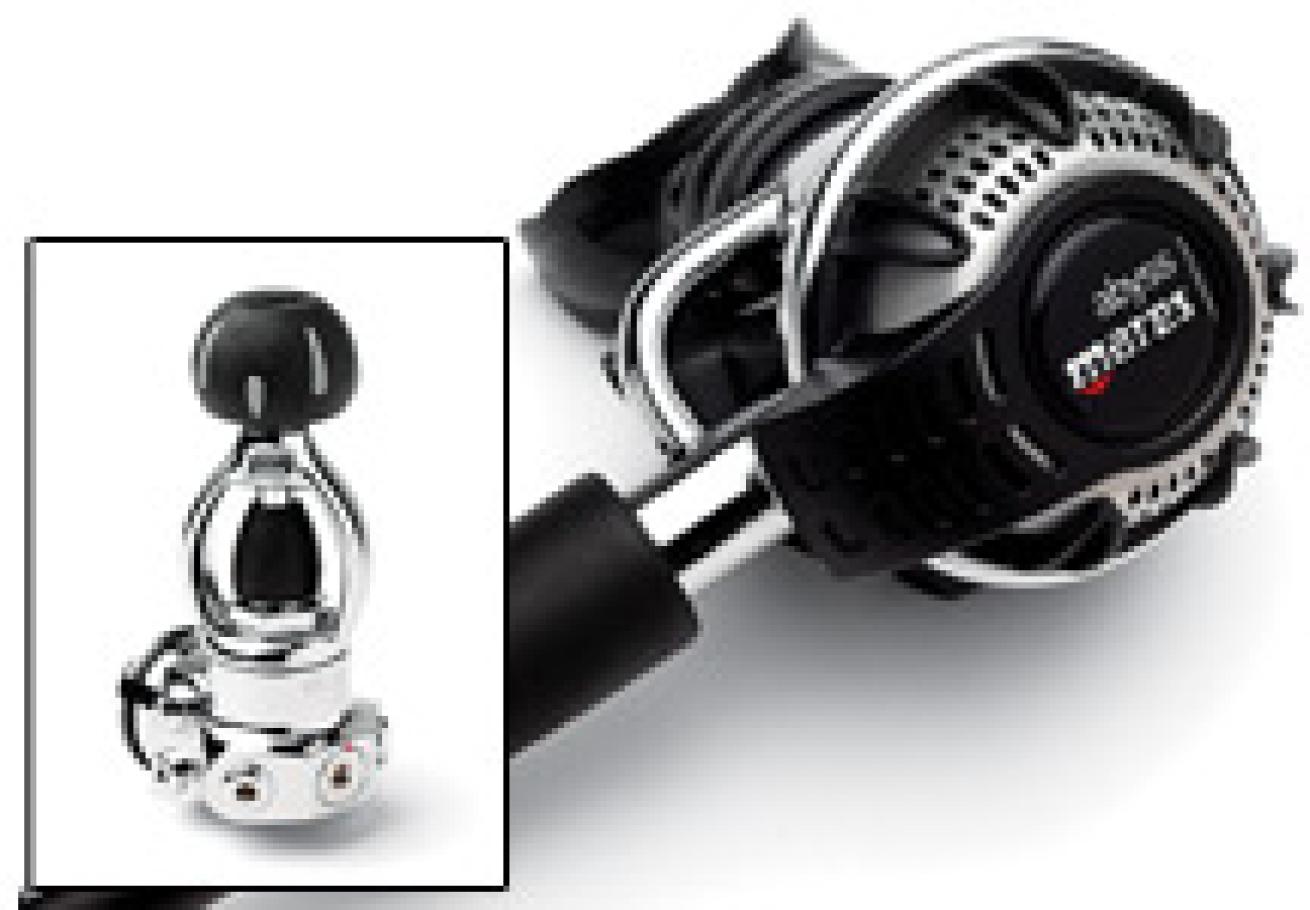
| | MARES Abyss 05|
Scuba Lab: Tester's Choice
Simulator score: 22 out of a possible 25.
Ergo Score: 57 out of a possible 70.
With an all-metal, non-adjustable second stage and a beefy, balanced diaphragm first stage, the Abyss 05 is simple to use and virtually bulletproof. The second stage is made of nickel and chrome-plated brass and incorporates Mares' Vortex Assisted Design (VAD) to improve breathing at all depths. The air coming through the low-pressure hose is directed to the mouthpiece through a bypass tube, creating a vortex that, according to Mares, increases breathing sensitivity. The MR22 first stage uses Mares' Dynamic Flow Control (DFC), a system that minimizes intermediate pressure drop during inhalation. With less inhalation resistance, breathing is easier.
So easy, in fact, that the Abyss tied for the second-highest breathing simulator performance in its price range. In ocean tests, it earned an Excellent for ease of breathing in the swimming position and Very Good for breathing in different positions. According to test divers, the reg breathes effortlessly, is quiet and stays dry regardless of what position you're in. The purge button is responsive, too. Made of metal, the second stage is a bit heavier than some other regs, but it's still comfortable. Test divers also liked the look of the second stage.
|| |---|
|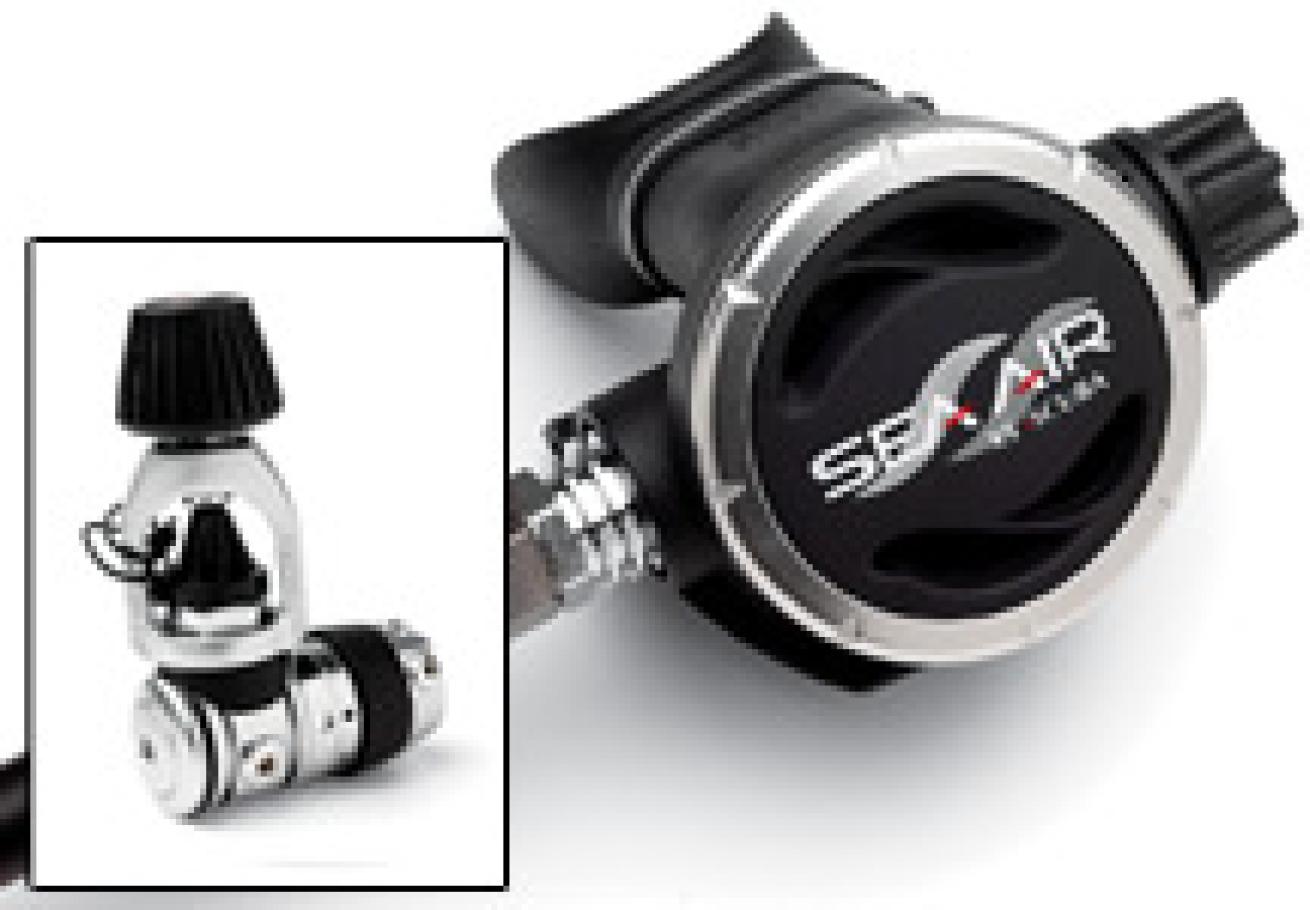
| | XS Scuba SeaAir Tri-Metal|
Scuba Lab: Tester's Choice, Best Buy
Simulator score: 22 out of a possible 25.
Ergo score: 56 out of a possible 70.
According to XS Scuba, the SeaAir Tri-Metal (so named because of its stainless-steel, titanium and brass components) delivers the performance of today's most expensive regs, yet is moderately priced. Based on our test results, this claim is grounded firmly in fact. Within the parameters of our standard breathing simulator tests, the Tri-Metal demonstrated Very Good to Excellent performance. Then it kept going. As RMVs and test depths increased, this reg continued to deliver air at a surprisingly low work of breathing. In short, the SeaAir Tri-Metal proved to be a real powerhouse when pushed to extremes.
The reg also proved more than able in actual ocean conditions, racking up Very Good scores in almost all ergo categories. Test divers found the reg to be a sweet breather in all positions and dry as a bone. The purge cover on the balanced second stage is a bit stiff, but unleashes a forceful rush of air for easy clearing. Although somewhat sticky, the breathing resistance knob gives you a full range of adjustment in only a couple of turns. The Tri-Metal's balanced piston first stage features a low-pressure port turret for easy hose routing and is the only reg in this group to come with a yoke rated for 4,000-psi cylinders. It carries a limited lifetime warranty. Based on its chart-topping performance and a reasonable price of $375, it's a Best Buy.
|| |---|
|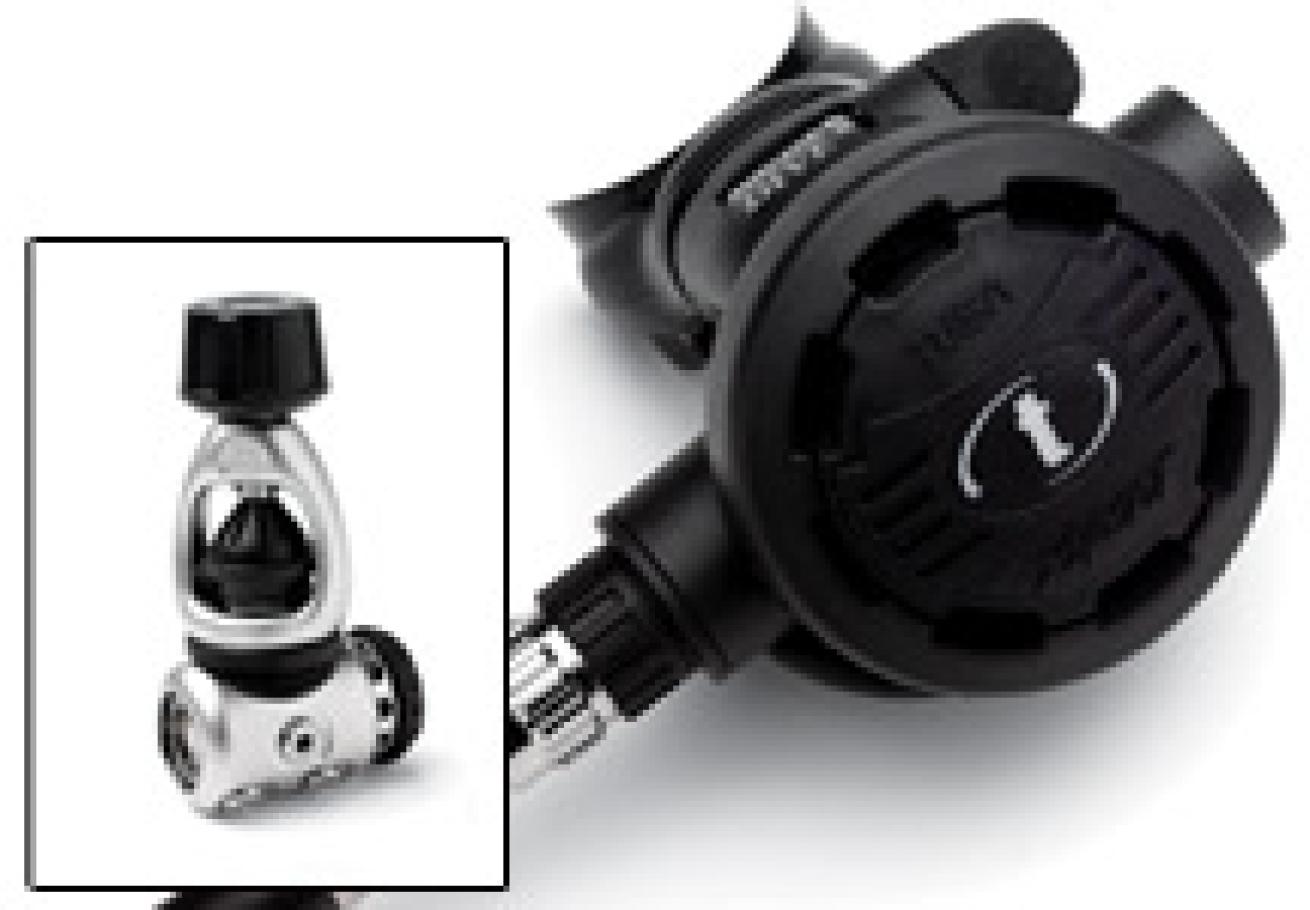
| | TUSA RS-460 X-Pert|
Scuba Lab: Tester's Choice
Simulator Score: 22 out of a possible 25.
Ergo score: 54 out of a possible 70.
Tusa's new RS-460 is a simple and efficient breather, combining a compact, balanced diaphragm first stage with a lightweight second stage. This reg tied for the second-highest breathing simulator performance in its price group and brought home Very Good scores in virtually every ergo category. According to test divers, this is a very easy breather in all positions. The reg purges effortlessly using the blowing method; the purge cover is stiff but efficient. The dive/pre-dive switch is clearly marked and easy to use, although it can be a bit hard to grasp when wearing gloves. Test divers found the reg to be dry in all positions, with a comfortable mouthpiece.
The RS-460 has two high-flow low-pressure ports on its first stage to maximize air delivery to the second stage, regardless of tank pressure. The first stage also comes with a special coating on the main spring to ensure that the regulator performs just as well in cold water. It's available with either a yoke or 300 bar DIN connection and comes with a lifetime warranty (including free parts replacement) if you purchase it from an authorized Tusa dealer and have it serviced once a year.
Under $500 Very Good Performers
While they didn't collect enough points to land in the Testers' Choice category, these regs still offer above-average breathing performance. All regs earned Good to Very Good scores in the most important ergo categories, too, with the Alpha 8 Sport leading the pack with an Excellent score for dryness.
|| |---|
|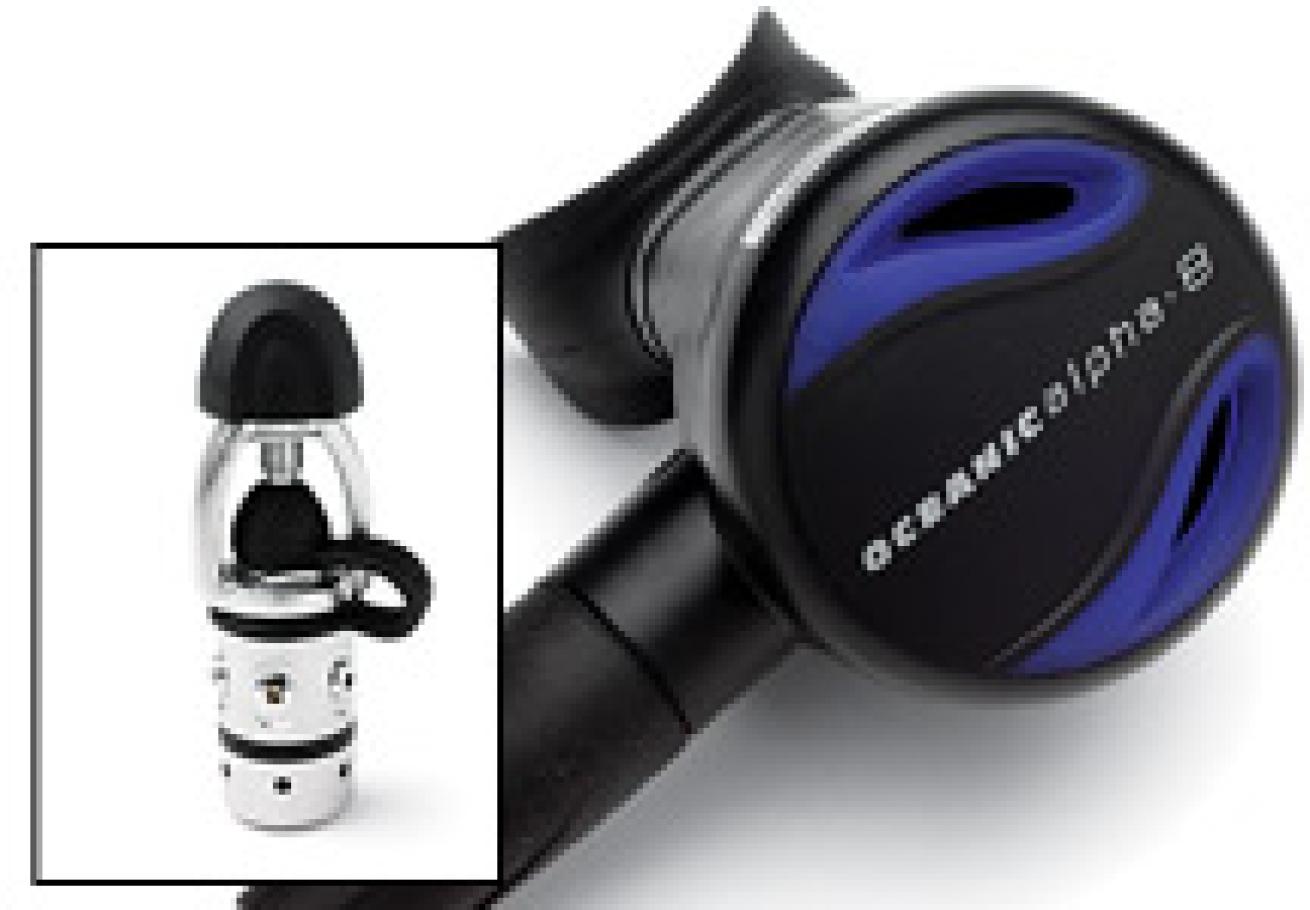
| | OCEANIC Alpha 8 Sport|
Scuba Lab: Best Buy
Simulator Score: 17 out of a possible 25.
Ergo score: 57 out of a possible 70.
Oceanic's new Alpha 8 second stage replaces the popular Alpha 7. Hooked to Oceanic's new SP-5 piston first stage, which is smaller and lighter than its predecessor (the SP-4), this combo offers divers a great entry-level reg.
The Alpha 8 Sport generated Very Good simulator scores in the breathing rate/depth category most closely representing typical recreational diving, and in the water it performed with panache. Test divers found it to be "very simple and lightweight" and "a nice basic reg." The Alpha 8 Sport, which has no user adjustments, was rated above average for ease of breathing in all positions (divers noted hardly any change in breathing, even when upside down) and for its purging efficiency (the flexible purge cover was very easy to use). Finally, the Alpha 8 Sport was the only reg in its price class to earn an Excellent score for dryness in all positions. Great performance for just $224.95--it's a Best Buy.
|| |---|
|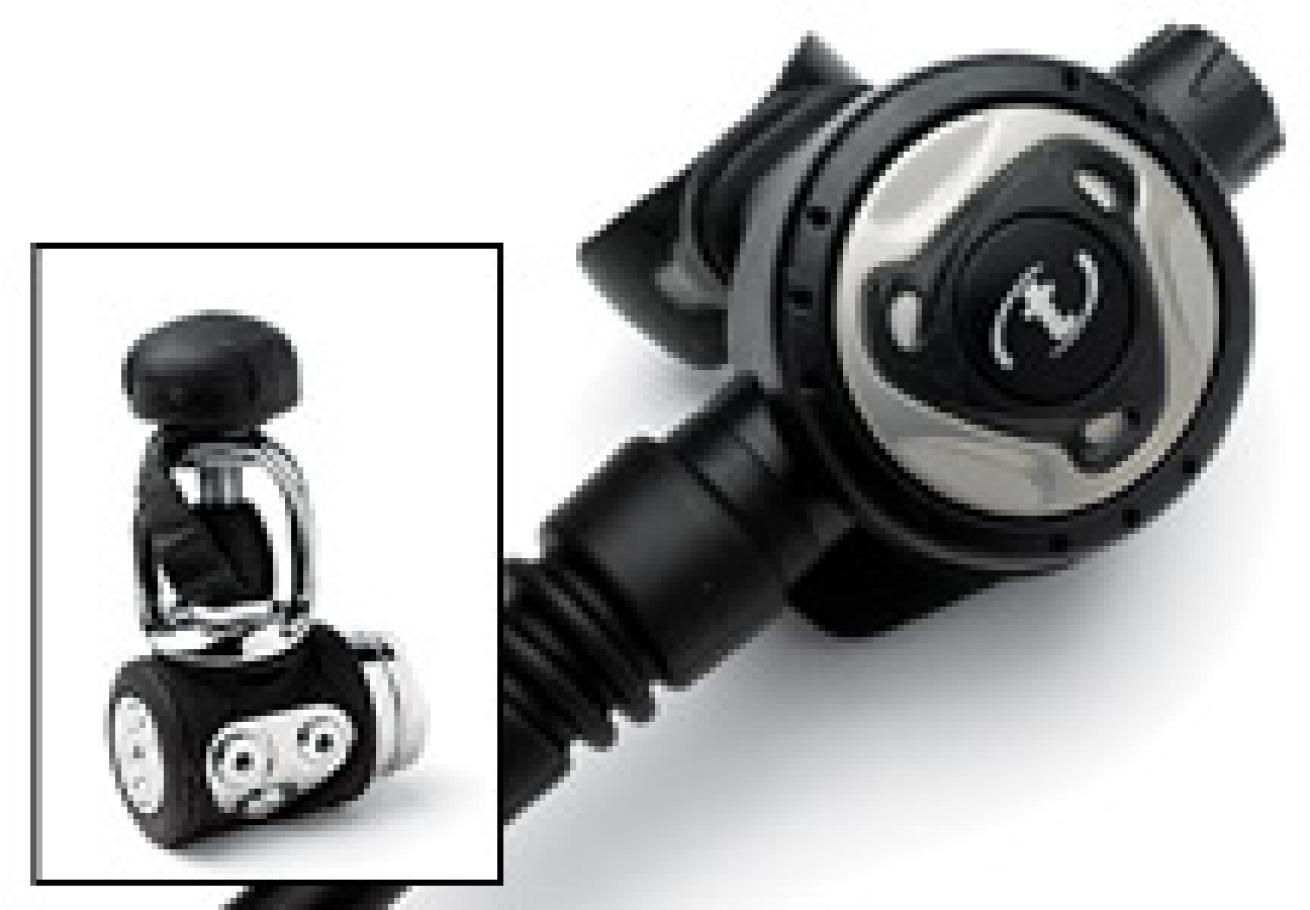
| | TUSA RS-340|
Simulator Score: 17 out of a possible 25.
Ergo score: 56 out of a possible 70.
On the simulator, the RS-340 earned Good to Very Good scores for breathing performance, but it was in real-world diving conditions where the reg really strutted its stuff. Test divers rated it Very Good, both for ease of breathing in all positions and for dryness, and noted the reg generated less bubble interference than most. The purge system was also rated high for its efficiency, using either the blowing method or the easy-to-use purge button.
Test divers were drawn to Tusa's new ortho-designed mouthpiece. They also liked the second-stage swivel (located between the low-pressure hose and housing) that improved positioning and helped minimize jaw fatigue. And even those test divers who were not fans of second-stage adjustments liked the reg's clearly marked 10-position positive-click breathing resistance knob. The RS-340 comes with a lifetime warranty, including free parts, if you purchase it from an authorized Tusa dealer and have it serviced annually.
CRESSI-SUB Ellipse Titanium
|| |---|
|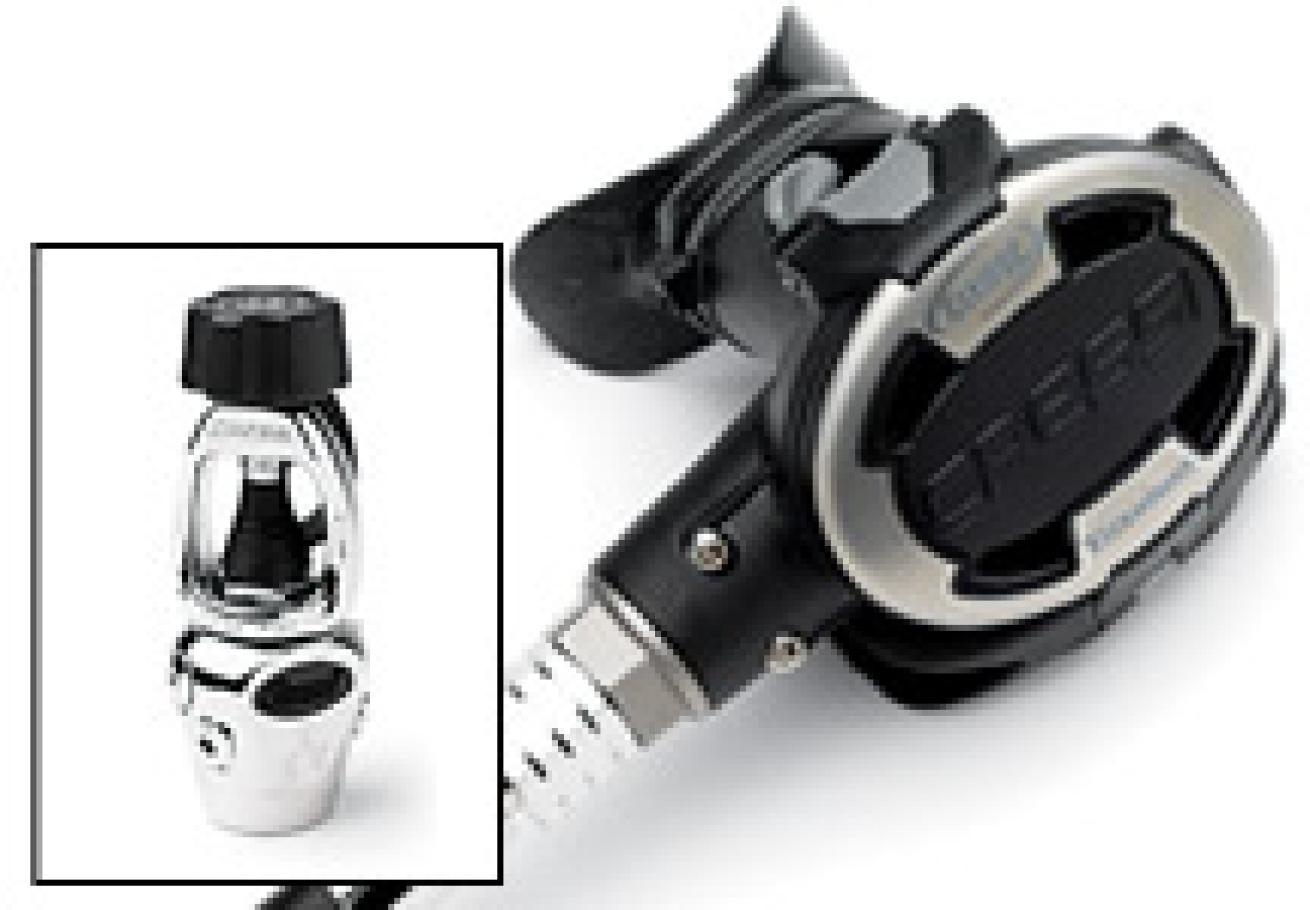
| | CRESSI-SUB Ellipse Titanium|
Ergo score: 54 out of a possible 70.
Divers who prefer a simple, lightweight second stage will like the Ellipse Titanium. According to Cressi-sub, the elliptical shape of the second stage allows them to use a larger diaphragm, which lowers breathing effort. Coupled to a compact first stage, the reg delivered Good to Very Good performance on the breathing simulator. In the water, it proved to be a solid breather, earning Very Good scores for ease of breathing in all positions. The reg also stayed dry at depth, and purged well using both blowing and button methods--although the purge cover is a bit stiff.
Test divers found the dive/pre-dive switch to be clearly marked and easy to use. However, they said the switch didn't do much to rein in free-flows. They also noted that our test reg delivered air with a noticeable plastic "new reg" taste to it. When we reported this to Cressi-sub, they said it tends to disappear after just a few dives (sure enough, it did). The Ellipse Titanium comes with a limited lifetime warranty, and is available in a cold-water version, the Ellipse Alaska.
|| |---|
|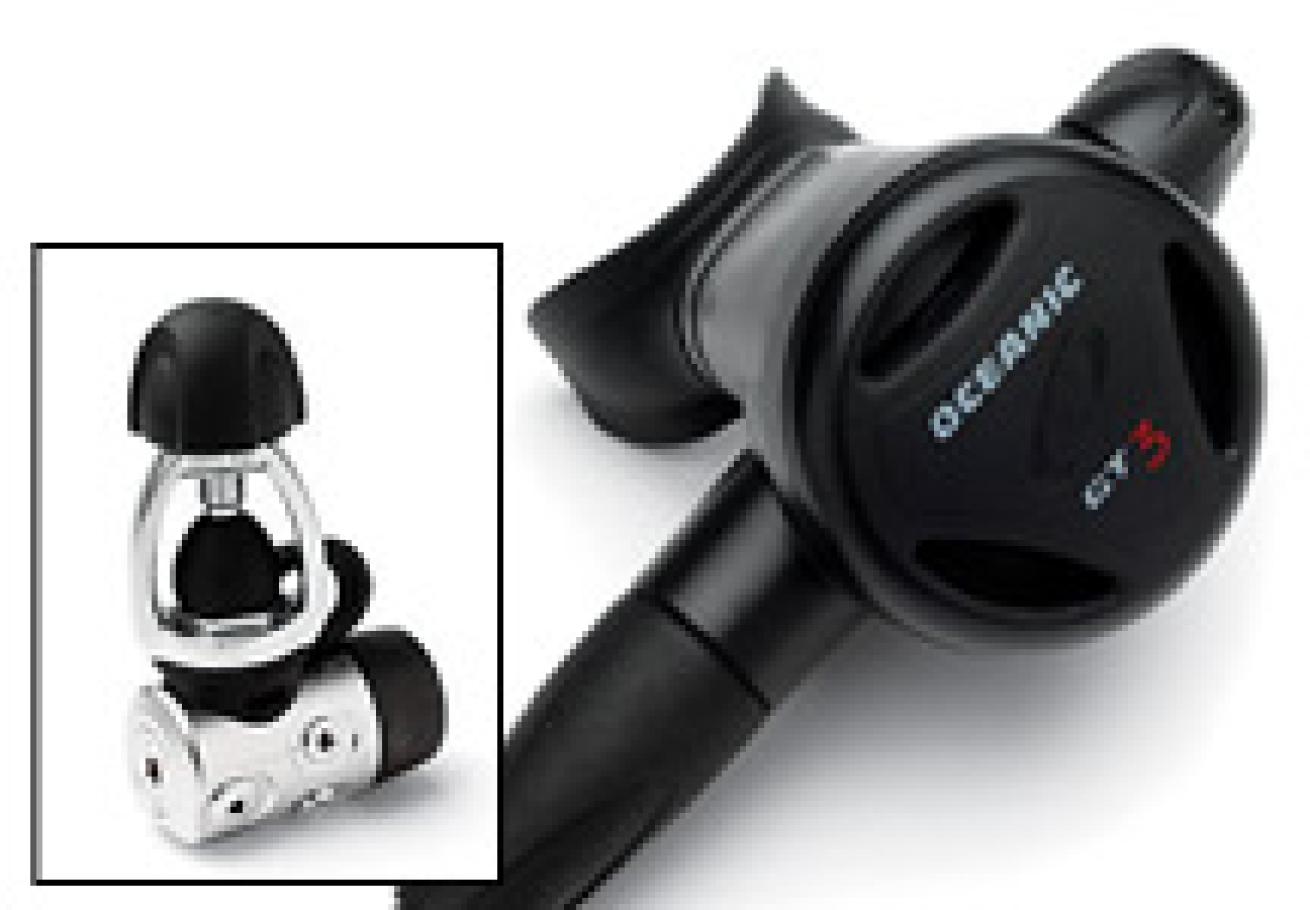
| | OCEANIC GT 3/CDX-5|
Simulator Score: 17 out of a possible 25.
Ergo score: 54 out of a possible 70.
Like Oceanic's Delta 4, the new GT 3 hits the scene equipped with Dynamic Adjustment, a second-stage balancing system that maintains consistent opening effort throughout the dive. Simply find your desired inhalation effort by dialing the adjustment knob in or out. Then leave it alone; the reg will automatically adjust itself to any changes in depth. The GT 3 doesn't come with a dive/pre-dive switch. According to Oceanic, the redesigned casing eliminates the need for this additional adjustment.
The CDX-5 first stage is a balanced diaphragm design that's equipped with an environmental kit for cold-water diving. Teamed up with the GT 3, this reg combo delivered Very Good performance on the breathing simulator in the RMV/depth category representing recreational diving. It then went on to earn Good marks at higher breathing rates and greater depths. In the water, the GT 3 proved to be a comfortable reg with its ortho-designed mouthpiece. Test divers rated it Very Good for ease of breathing in all positions, and found it to be a dry reg in all situations.
|| |---|
|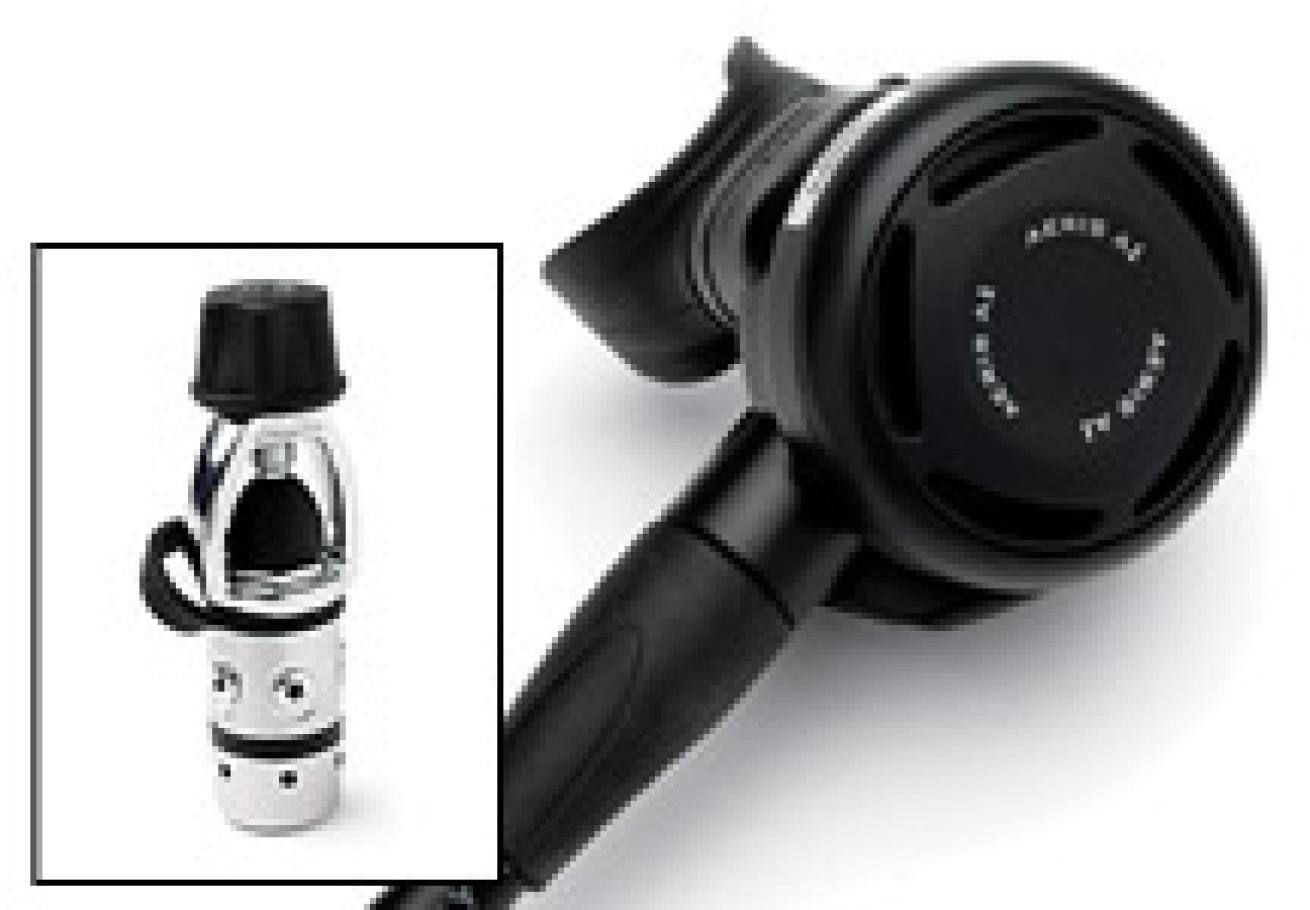
| | AERIS A1|
Simulator Score: 17 out of a possible 25.
Ergo score: 54 out of a possible 70.
Comments from divers reaching the surface after test-diving the Aeris A1 included "Surprisingly easy breather," "Great reg," and simply, "How much? I'll take it!"
The reg is designed with simplicity in mind. The second stage, made of a lightweight ABS/polycarbonate composite, has no user adjustments, and the compact first stage is an unbalanced piston design. The reg easily delivered Very Good breathing simulator performance in the RMV/depth category representing typical recreational diving--the category it was designed for. It also earned Good simulator scores in tests using the more extreme depths and breathing rates. According to Aeris, the sweet breathing characteristics of this reg are due to a unique second-stage deflector vane and housing design that produce smooth venturi-assisted inhalation.
Ergo tests bear this out. Test divers rated the A1 Very Good for ease of breathing in all positions and for dryness. The reg's purge system also scored points for efficiency. An orthodontically designed mouthpiece contributed to the reg's Very Good score for comfort. {mospagebreak} Under $500 Very Good Performers - continued
|| |---|
|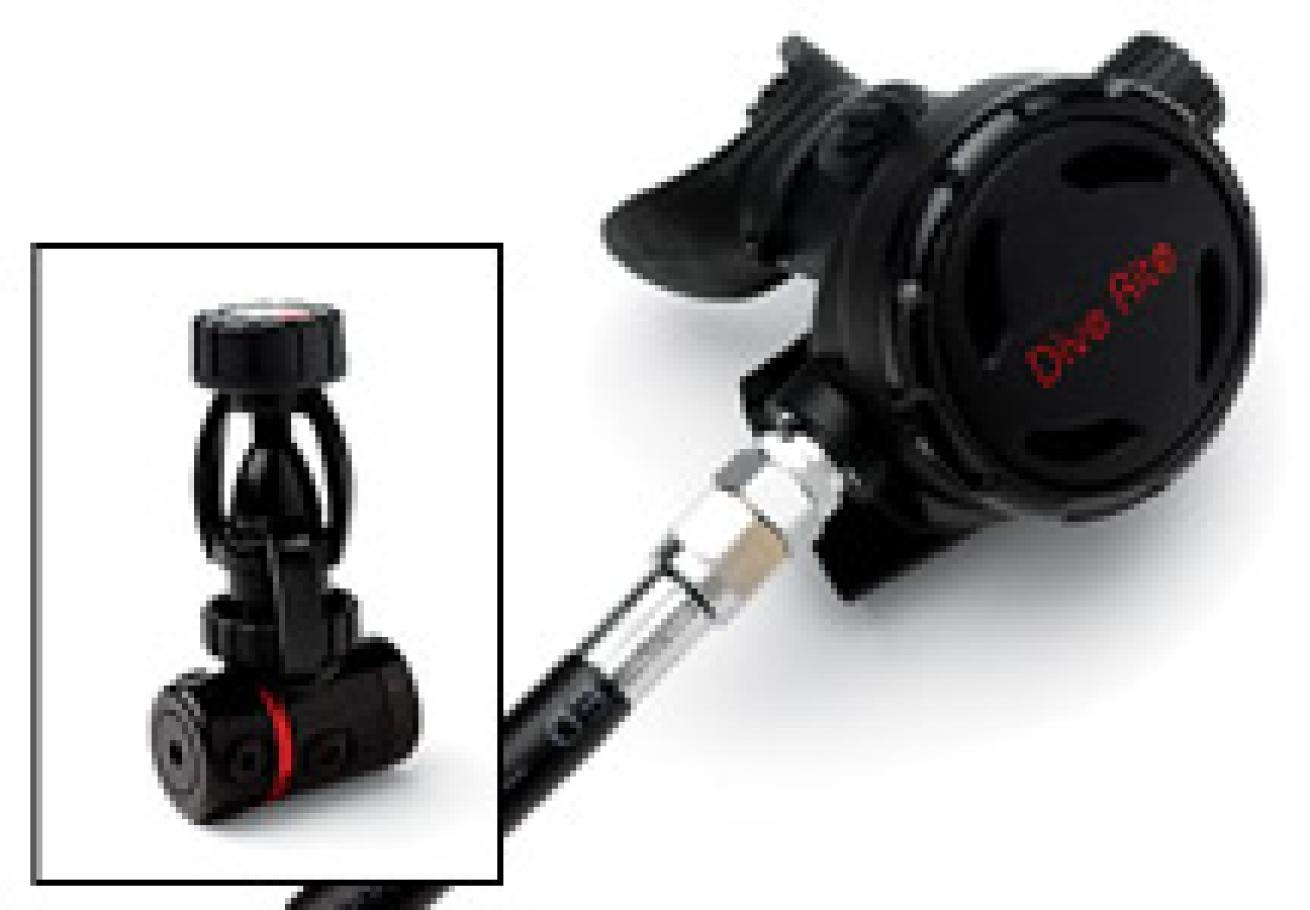
| | DIVE RITE RG2500|
Simulator Score: 18 out of a possible 25.
Ergo Scores: 53 out of a possible 70.
Dive Rite's new RG2500 is the only reg in this go-round that comes standard with a DIN valve (a yoke-style adapter, pictured, is available). The no-nonsense first stage offers a rotating low-pressure port turret to simplify hose routing. The balanced second stage features a breathing resistance knob with a wide range of adjustment.
On the simulator, the RG2500 earned Very Good to Excellent scores in the first three breathing machine tests. During ocean tests, the reg earned Very Good marks from test divers for ease of breathing in the swimming position and for dryness. It also had less bubble interference than most regs. Divers liked the flexible purge cover, but felt the markings on the dive/pre-dive switch were hard to see. In response to these comments, Dive Rite reminded us that the lever is designed to point up the hose when the reg is in dive mode. This provides a tactile indicator useful in low-visibility situations. The RG2500 comes with a limited lifetime warranty and two-year service program. It's also available in a cold-water version, the RG2500 Ice.
|| |---|
|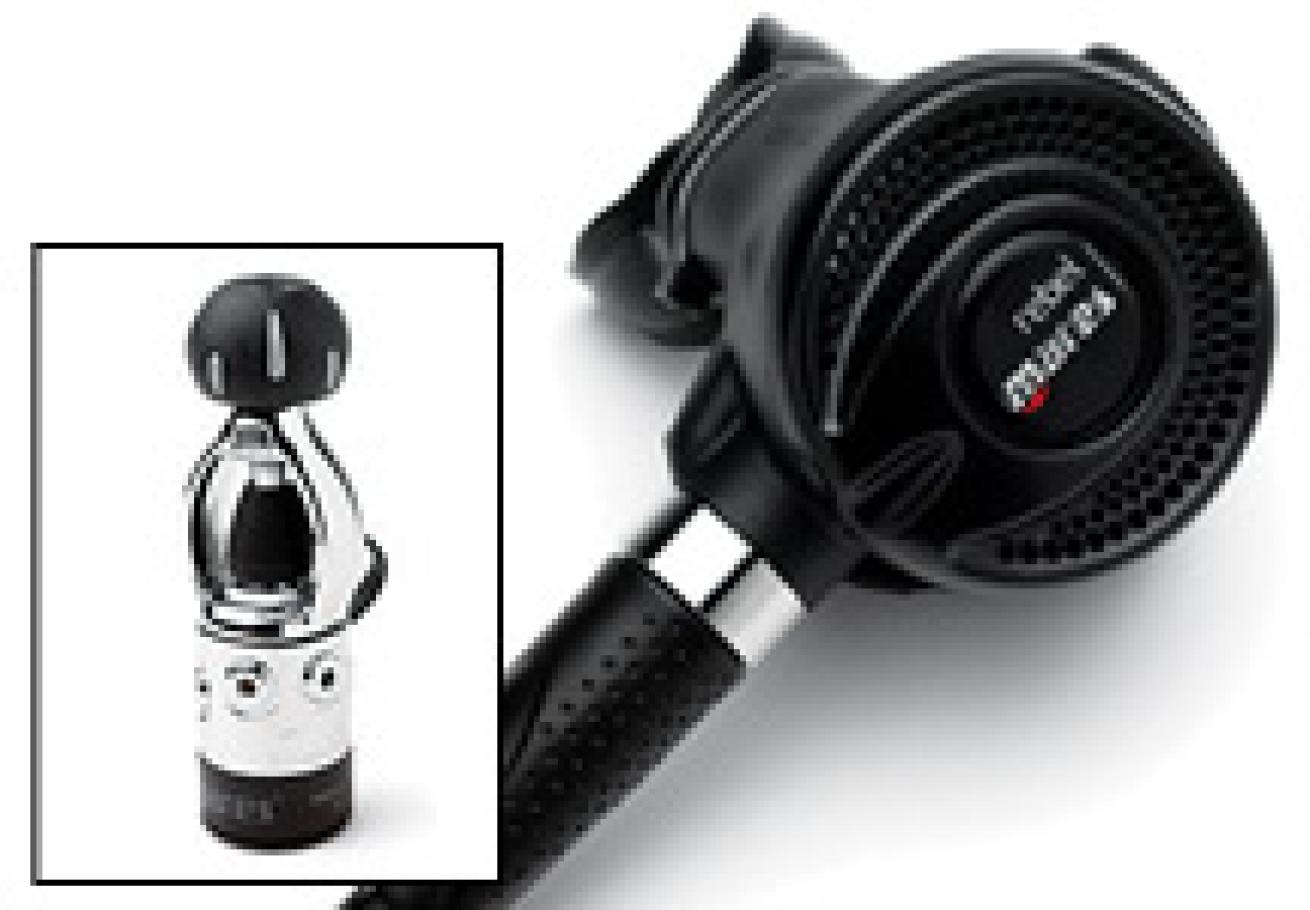
| | MARES MR12 Rebel|
Simulator Score: 22 out of a possible 25.
Ergo score: 48 out of a possible 70.
Simplicity is the key for Mares' new Rebel, which is both lightweight and free of user-adjustments. The reg also uses a mesh grid second-stage faceplate designed to minimize free-flows when swimming into strong currents. Like the Abyss 05, the Rebel also incorporates Mares' Vortex Assisted Design, or VAD, a system designed to improve breathing at all depths. The tried-and-true MR12 first stage uses Dynamic Flow Control, a priority low-pressure port for the primary second stage.
The Rebel tied for second-highest performance on the breathing simulator in the Under $500 price group. It earned an Excellent score in the RMV/depth category most closely representing recreational diving and Very Good scores in all other categories.
In the water, test divers scored the reg as a Good breather both in the swimming position and in alternate positions, and found it to be a very dry breather in all positions. Among its highlights: a purge button that is easy to find and that works efficiently. The Rebel's mouthpiece is comfortable too.
Back to the Future: AQUA LUNG Mistral
|| |---|
|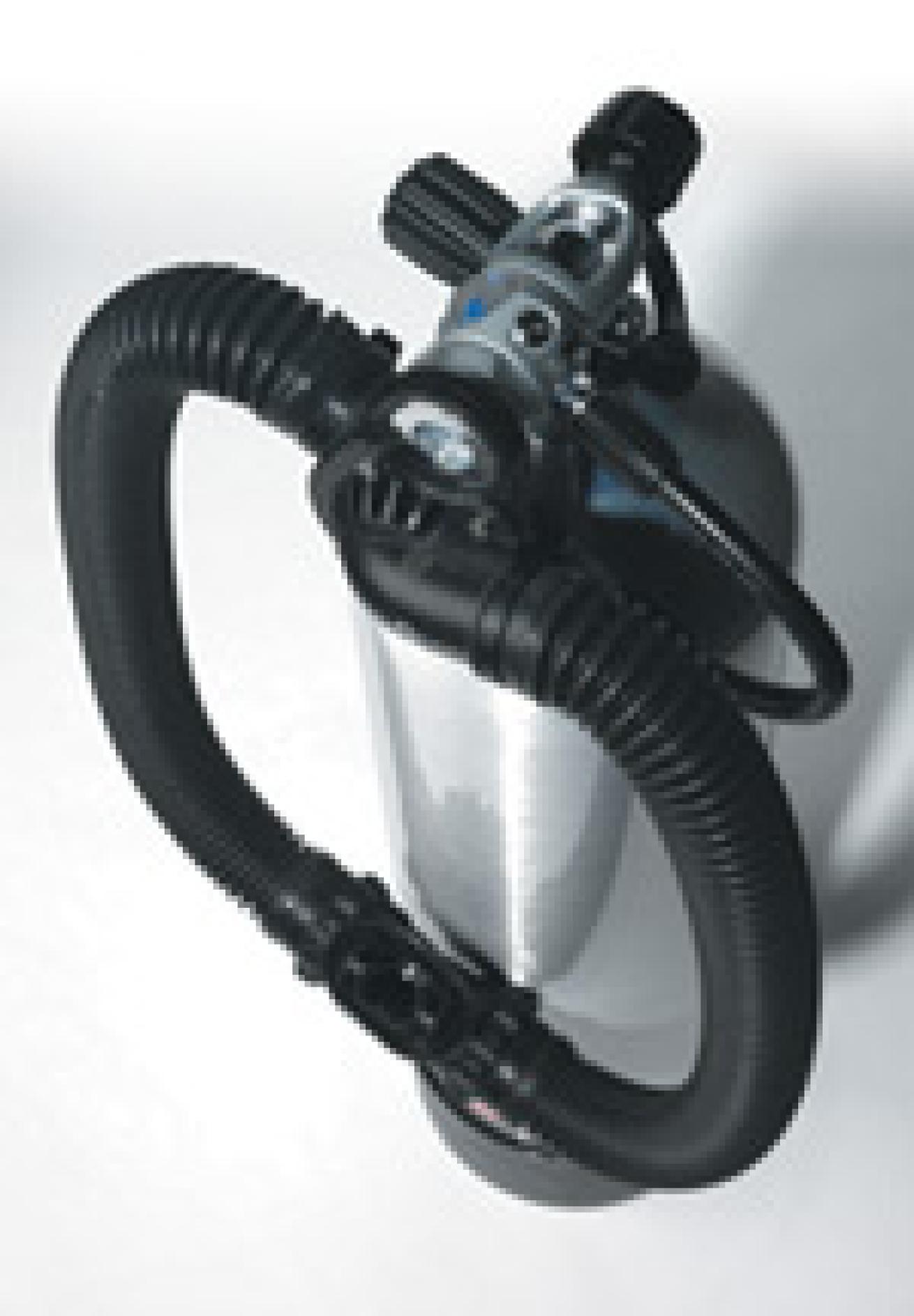
| | AQUA LUNG Mistral|
This is still a double-hose reg, however, and subject to the laws of physics. When you're vertical in the water the Mistral breathes just as easy as a single-hose reg (the equivalent of a Very Good score according to our breathing machine tests). And it breathes extremely easy when you're looking up or swimming on your back. But when you go facedown, as in a head-first descent or in the standard swimming position, inhalation effort increases markedly.
For divers used to breathing off a single-hose reg this will take some getting used to, as will the old-school steps for purging the reg and buddy breathing. But if you want to explore the "good old days of gorilla diving," it's just part of the fun. Price: $900. For more information, visit www.aqualung.com.
Fashionably Late
|| |---|
|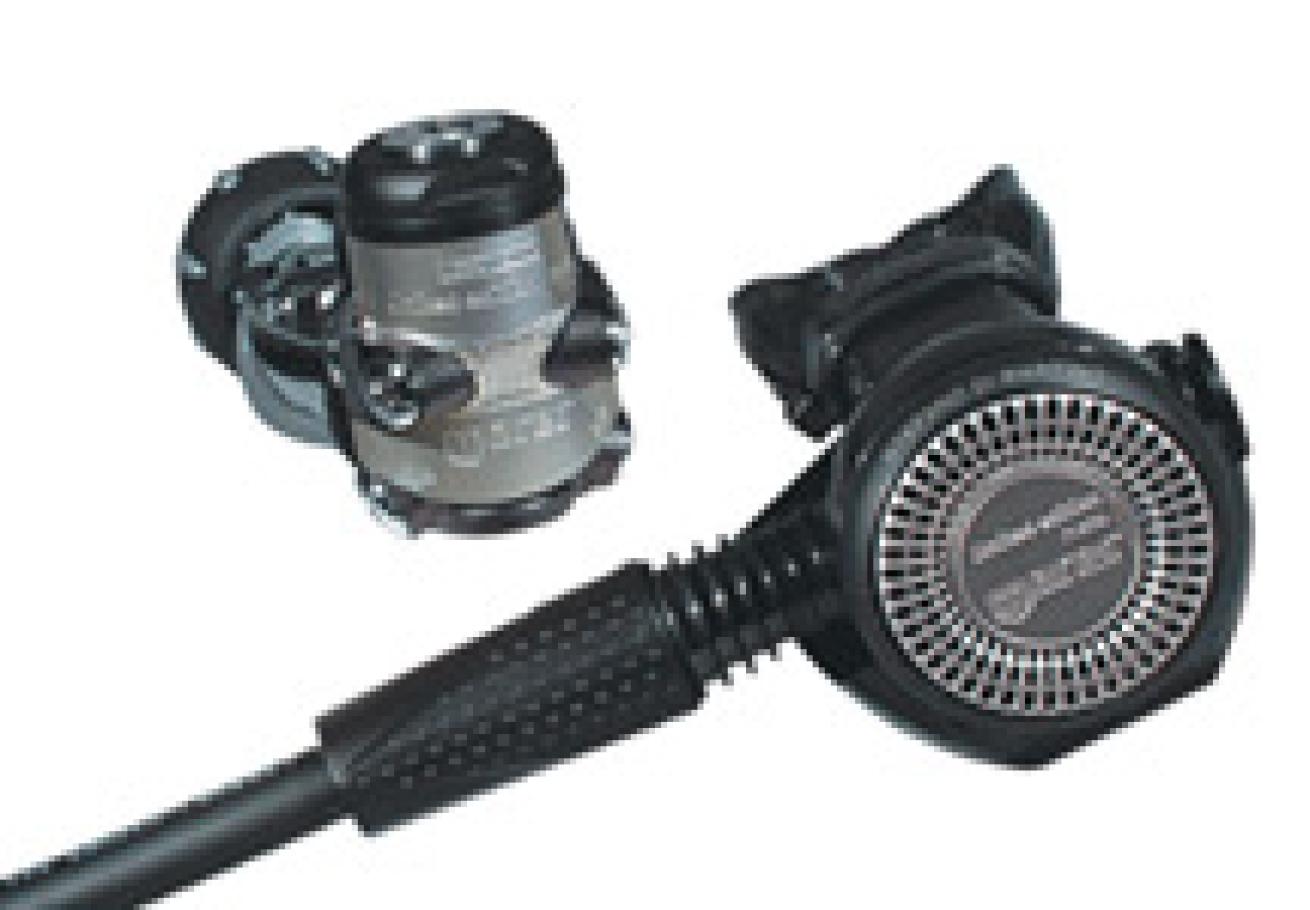
| | MARES Metal Tech LE|
MARES Metal Tech LE > Part of Mares' new Limited Edition Metal line of dive gear, the Metal Tech LE first stage is 60 percent lighter than any reg made by Mares and features Dynamic Flow Control on all low-pressure ports. Only 2,000 of the regs were produced, and buyers can have their name engraved on the outer ring of the second-stage cover. Price: $699. The reg can be purchased with other Limited Edition gear--the Morphos Metal Tech LE buoyancy compensator and the Quattro Excel Metal LE fins.
ATOMIC Z2 > The second generation of Atomic's budget regulator, the Z2 promises to deliver the same breathing performance as its T2, B2 and M1 cousins. According to Atomic, it features a pneumatically balanced second stage, Atomic's Automatic Flow Control, a titanium seat-saving orifice, a rapid adjustment knob and a new second-stage casing. Price: $399.
|| |---|
|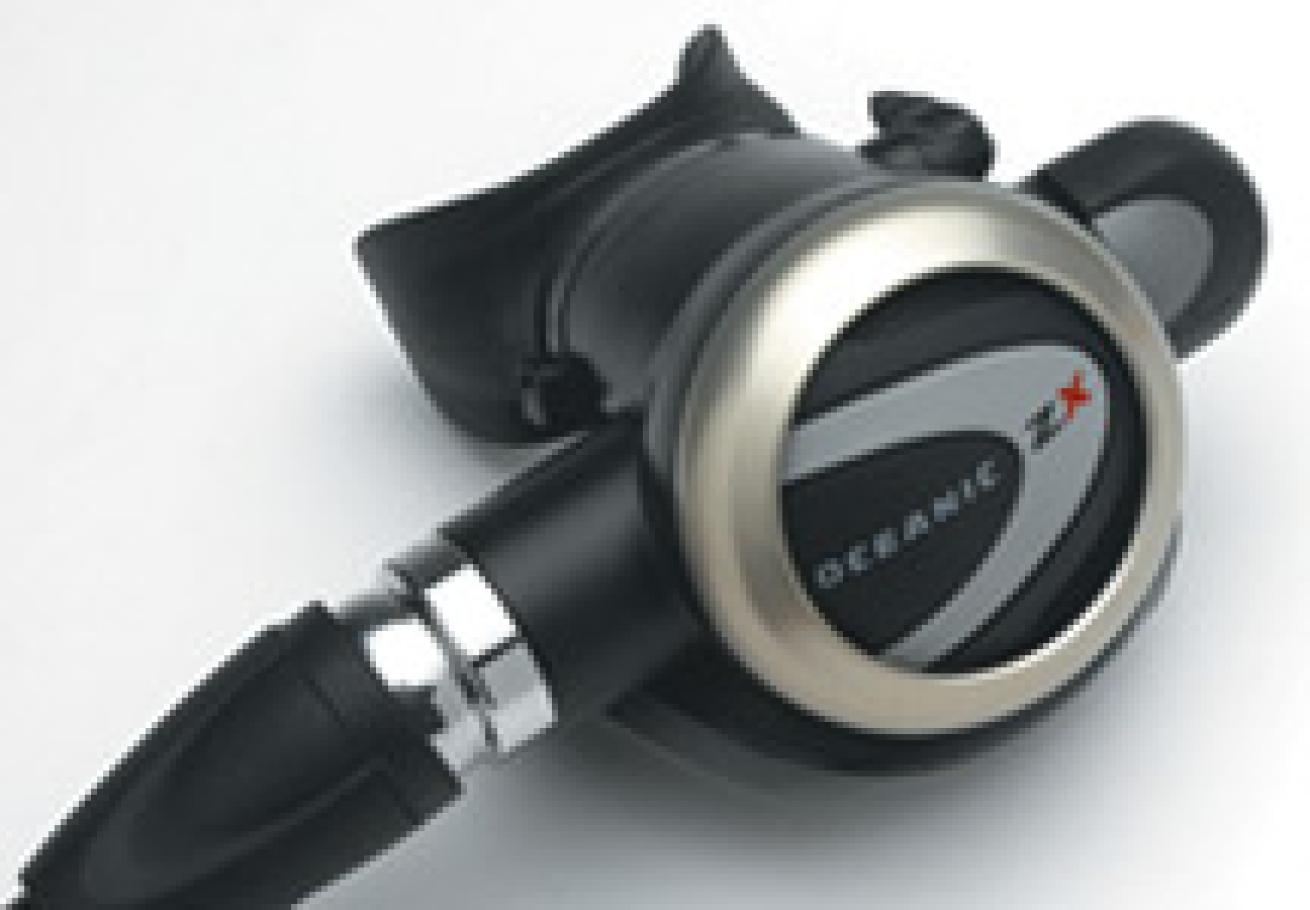
| | OCEANIC ZX|
Oceanic Alpha 8/PX-3 > This is the same second stage used on the Alpha 8 Sport, mated to a balanced piston PX-3 first stage. New for this year, the PX-3 now comes with a fifth low-pressure port to increase hose placement options. Price: $299.95.
2004 Testers' Choices
Still looking for the perfect reg? Here are last year's top performers and their test scores. They're still in distribution, and definitely worth a look.
Under $500
Aqua Lung Calypso
Simulator Score: 19 out of a possible 20.
Ergo Score: 53 out of a possible 70. An updated version of an old favorite, the Calypso is a dry, easy breather that offers a lot reg for not a lot of money.
Price: $269.
Mares MR12/Axis Pro
Simulator Score: 19 out of a possible 20.
Ergo Score: 50 out of a possible 70. A balanced diaphragm first stage hooked to a simple adjustment-free second stage. A great breather in the normal swimming position.
Price: $249.
Mares R2/Axis Pro
Simulator Score: 18 out of a possible 20.
Ergo Score: 50 out of a possible 70. Easy on the wallet, but packed with performance. This unbalanced piston first stage earned positive comments from test divers for its ease of breathing.
Price: $209.
Over $500
Scubapro MK25/X650
Simulator Score: 20 out of a possible 20.
Ergo Score: 57 out of a possible 70. Earned a perfect simulator score and the highest total score for ergonomic performance of any reg we tested in 2004.
Price: $602.
Zeagle Flathead VI/ZX
Simulator Score: 20 out of a possible 20.
Ergo Score: 55 out of a possible 70. Zeagle's flagship reg aced our simulator tests. In the water, test divers rated it Very Good for ease of breathing in all positions.
Price: $598.
Regulator Features to Consider
Piston or diaphragm first stage. > To admit air from the tank into the regulator, first stages use a piston sliding in a smooth cylinder or a diaphragm (like a loose drumhead) that flexes. Each has advantages and disadvantages, but both can offer excellent breathing performance.
> Balanced or unbalanced first stage. Balancing is an attempt to keep air delivery stable when tank pressures are low or demand on the regulator is high. However, many unbalanced first stages offer breathing performance very similar to balanced ones.
> Number of ports. More ports means better hose routing options.
> Balanced or unbalanced second stages. Balanced second stages can make the airflow more consistent, but most modern unbalanced second stages do just as well in the ergo and simulator tests.
> Dive/Pre-dive switch. A second-stage adjustment useful to prevent free-flows on the surface. > Breathing resistance knob. Designed to be used under water, they can be used to tune out positive pressure breathing and free-flows caused by current.
> Nitrox capability. In this test, all the regs come factory-ready for oxygen-enriched breathing gases.
> Environmental sealing. Environmentally sealed first stages keep water out of the workings to prevent icing in cold (below 50 degrees) or contamination in dirty water.
> Warranty: Range from two-year limited to limited lifetime; some manufacturers offer upgraded warranties as an option.
How (And Why) We Test Regulators
Scuba Lab is the only consumer products testing organization that works for the sole benefit of recreational divers. The goal of our exclusive Scuba Lab reviews (found only in Scuba Diving magazine and archived on www.scubadiving.com) is to help divers be informed consumers of dive gear.
To fulfill this mission when testing regulators, we use an industry-standard ANSTI wet breathing machine, which is capable of measuring minute differences in the inhalation and exhalation resistance at a variety of depths and breathing rates. Following internationally accepted test standards, a regulator's work of breathing (WOB) is measured in joules per liter (j/l) for each complete inhale/exhale cycle, during which the highest inhalation or exhalation pressure experienced by the "diver" should never exceed 25 millibars or a total WOB of 3 j/l.
If a reg exceeds either parameter, it "fails" our test, but that doesn't mean that it stops delivering air--only that the breathing resistance at some point in the cycle is higher than what is common for most modern regulators. All simulator tests are performed at a supply pressure of 725-760 psi. If a regulator can perform well at this low supply pressure, it will perform as well or better at higher supply pressures.


